1lumen selects and reviews products personally. We may earn affiliate commissions through our links, which help support our testing.
Armytek Wizard C2 Pro Max LR review
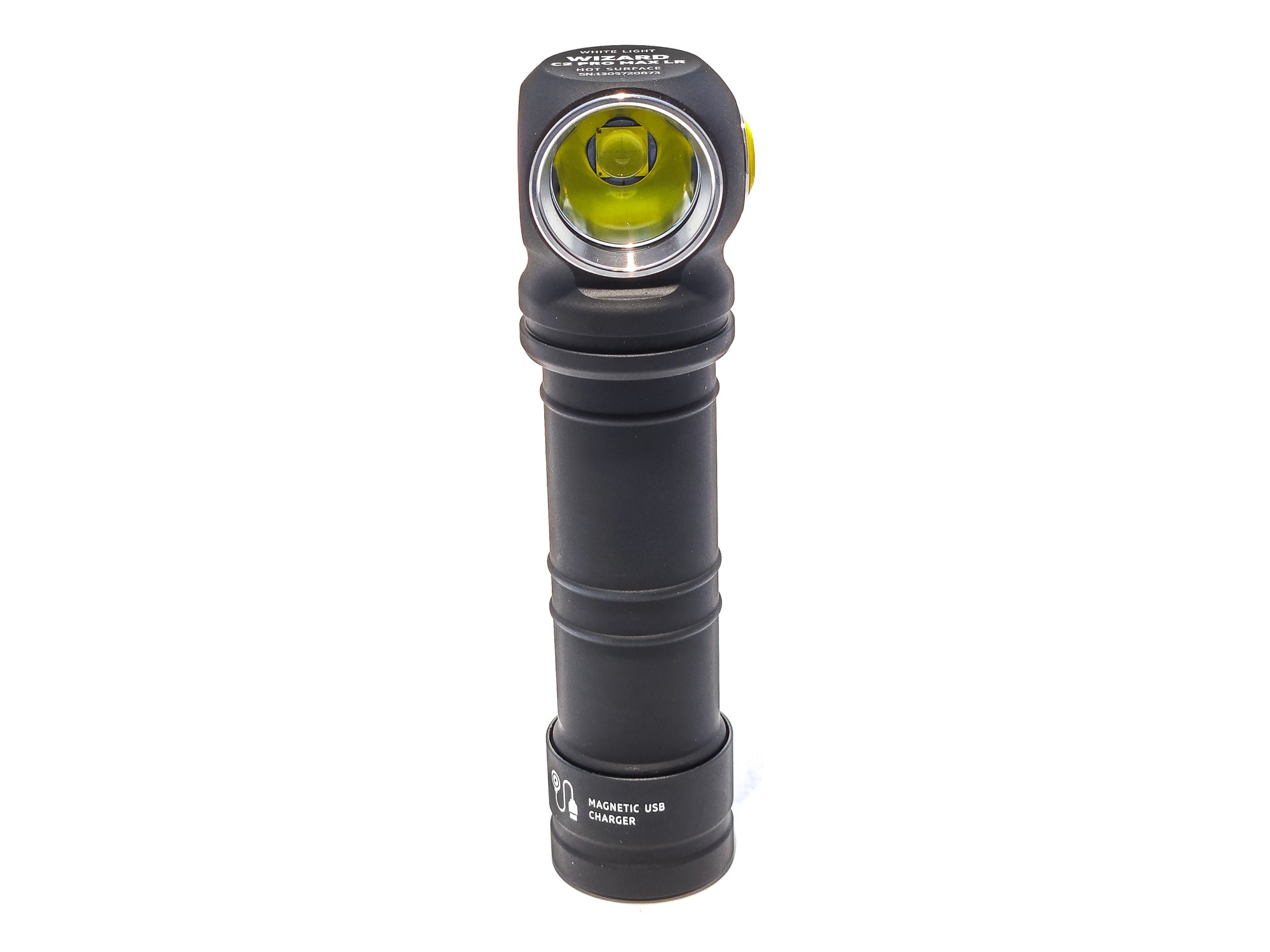
Armytek Wizard C2 Pro Max LR specs
| Brand & Model | Armytek Wizard C2 Pro Max LR |
|---|---|
| Flashlight category | Headlamp / EDC / Sports |
| LED | Cree XHP70.2 (cool white) |
| Max. output | 4150 lumens |
| Max. beam distance | 181 meters |
| Max. beam intensity | N/A |
| Battery config. | 1*21700; 1*18650 with adapter |
| Onboard charging | Proprietary magnetic |
| Main modes | 6 standard, 7 advanced |
| Blinkies | 1Hz low, 1Hz turbo, 10Hz turbo |
| Waterproof | IP68 |
| Review publication date | January 2024 |
Review intro:
Armytek prides themselves on having a solid lineup of lights, both physically and performance-wise, which marries the tough requirements of army use with the latest technology (hence the name). The models in their flagship Wizard line of right-angle lights are largely variations on a theme, distinguished by their names, if not their looks. This particular model, the Wizard C2 Pro Max LR is the 21700 (Max) version of the 4th revision (C2) of the Wizard, featuring a smooth reflector (LR (long range)) and 6V Cree XHP70.2 emitter (Pro). Confused by the name? Don’t worry too much about it. I’ll just refer to it as “Wizard” from here on out, so keep reading.
Package quality.
Armytek’s packaging is definitely shelf-worthy with a full-color box packed full of information on nearly every square inch of its surface. Inside is a molded plastic tray with the light and accessories in divided compartments. The light itself is even in the included belt holster, which adds an additional layer of protection during shipping, and is a thoughtful use of space.
The complete contents of the box include:
- Nylon holster
- Armytek Wizard C2 Pro Max LR (inside the holster)
- Armytek 5000mAh 21700 flat top battery (inside the light)
- Plastic zip top bag with two spare o-rings and the pocket clip
- Magnetic USB charger
- Headband
- 18650 adapter
- Abbreviated instruction manual
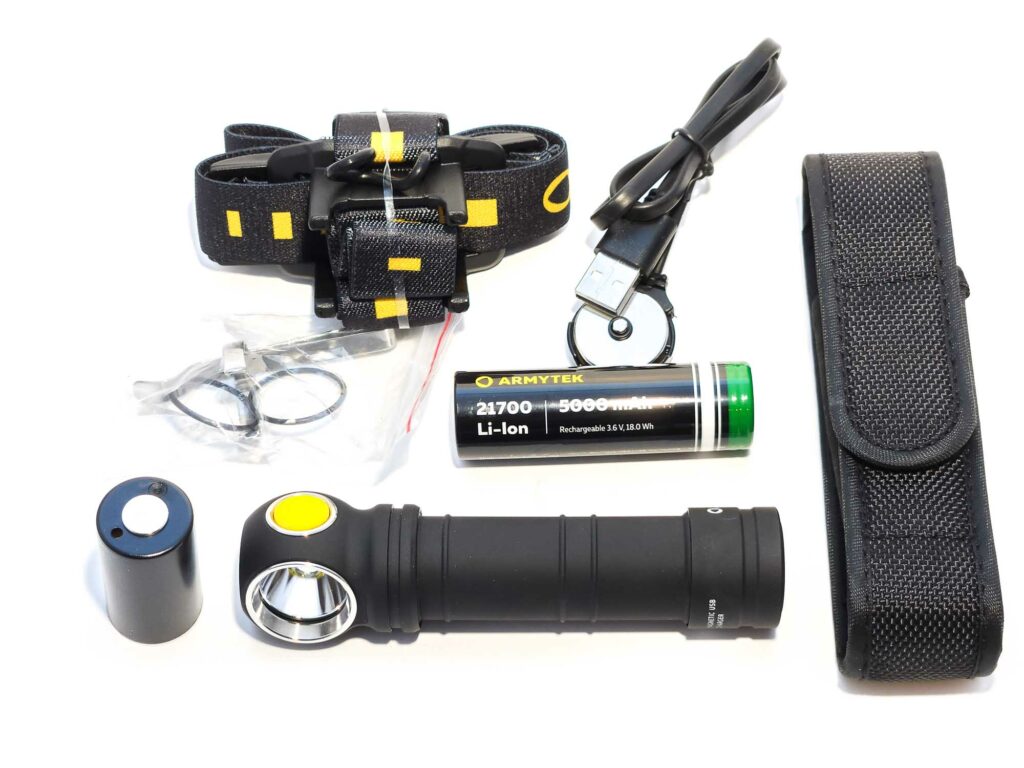
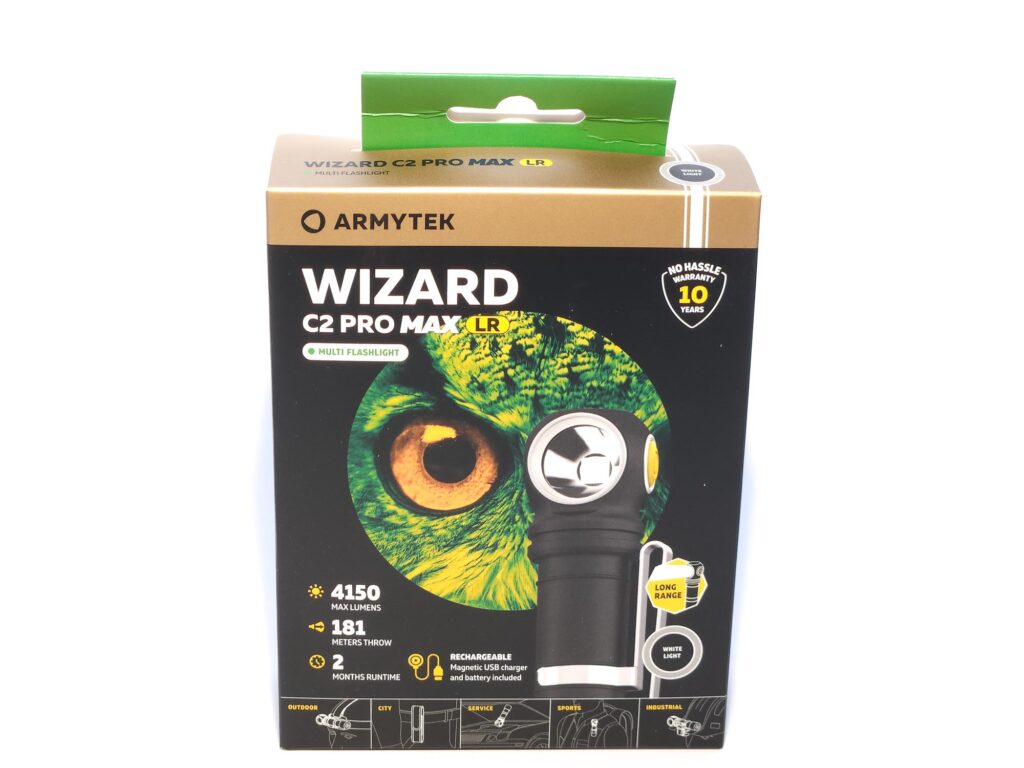
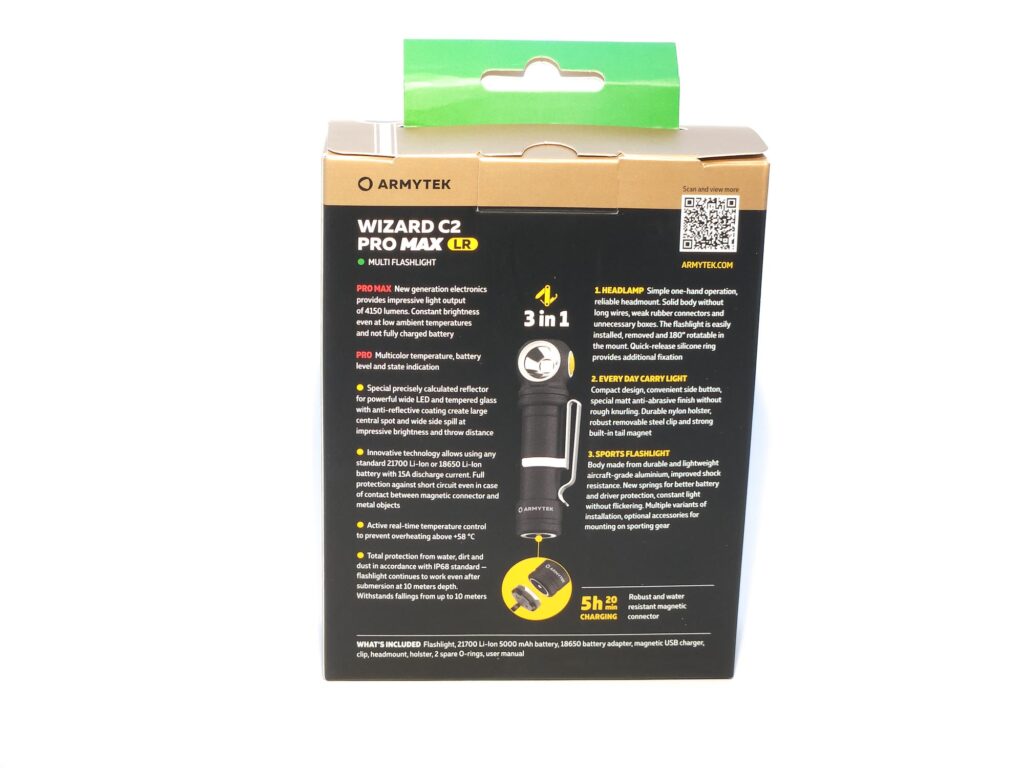
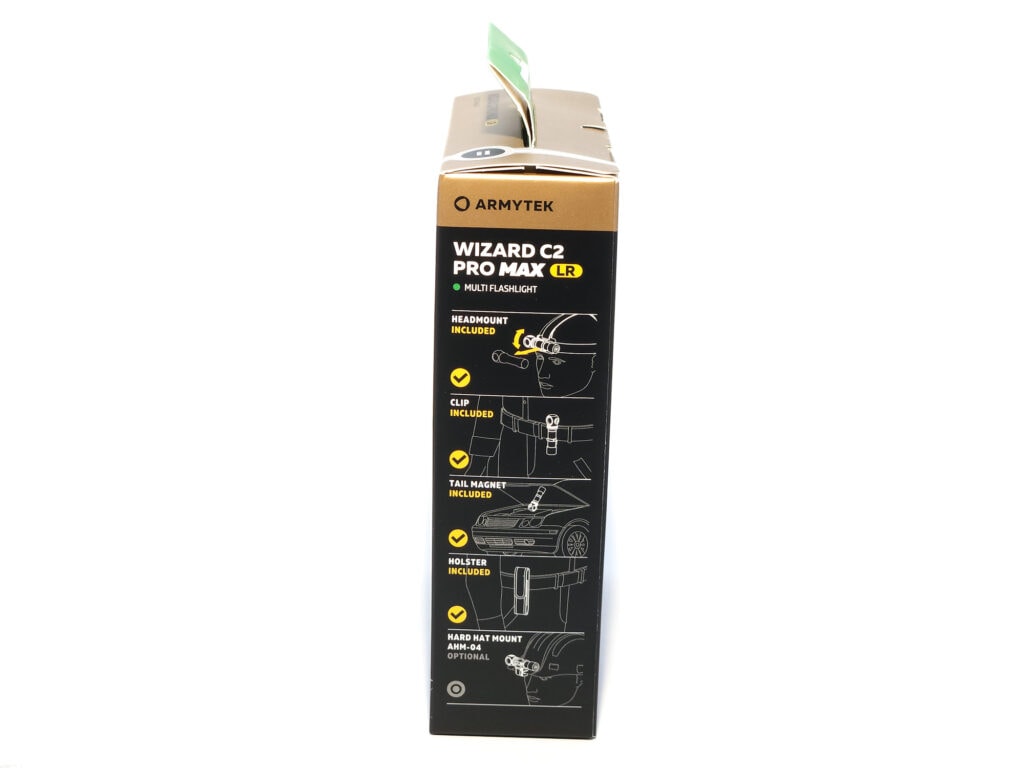
Flashlight in use, Build Quality, and Warranty
Being a 21700 light, the Wizard isn’t what I’d call pocketable, but you can do it. I’d rather carry it in a jacket pocket or the included holster. The included clip will hold the light pretty tightly if you want to clip it to a backpack or something, but at the end of the day it’s still a friction clip, so it could always fail. One nice thing about the clip is that you can use it in either direction, and it’ll be deep carry in both! It’s not every day you see that. Of course you’ll have to remove it from one side to put it on the other, and that will scuff the body of the light. Not scratch, but it will scrape away at the matte finish. Similarly, if you want to use the Wizard in its headband, you’ll have to take the pocket clip off since the clip from the headband uses the same channels on the body. Personally I’m not a fan of the way any matte finish feels kind of chalky, but as Armytek advertises, it does seem to help with grip. It also gets dirty fast from touching it.
The Wizard’s head is squared off, unlike other lights, so it’s less likely to roll around if you don’t have the clip on it. Armytek crammed the exceptionally long name and some other choice tidbits of text onto the top of the head, but at least it’s all in one place. They’ve placed the button on the side of the head, which makes for easy control while wearing it as a headlamp, since you can activate it with a pinching. It’s bright yellow and has an indicator light under the boot which lights up when you press the button or the battery is getting low.
The head and body are glued together, so you remove the battery by unscrewing the tail cap. I found it more difficult to unscrew than the tails of other lights, likely because of the dual o-rings it employs to get an IP68 rating, capable of staying 10 meters underwater for 2 hours. I don’t plan on testing that, or the advertised 10 meter fall rating, which is also surprisingly high for a light. Interestingly, even though the threads are not anodized, you can still lock out the light with a quarter turn of the tail cap. There’s even some kind of state memory, because even after completely removing the tail cap while the light was on, it turned back on when I screwed it back in.
Armytek added more branding to the light down here, including a fairly large diagram of the magnetic usb charger, which you clip onto the bottom of the tail cap. The exposed aluminum of the charging ring will scuff easily, especially when you stick it to things using the internal magnet. And boy, is that magnet strong! I’d say it’s one of the strongest tail cap magnets I’ve seen on a light. It has no problem keeping the Wizard horizontal on a ferrous surface at all.
I took a 3 mile (4.8km) walk with the Wizard in the included headband. In addition to the arms which the light clips into, there is also an o-ring which is pulled across the body to help secure it. It’s bigger than the light’s o-rings, so it can’t be used as a spare. The light is held firmly in place, but you can rotate and activate it with one hand, something that’s important when the point of a headlamp is to be hands-free. I did not experience any neck fatigue during my walk, though it may crop up on longer expeditions.
The Wizard works well as a handheld light, too, providing you’re holding it in your right hand. With the button being on the side of the head, it falls directly under your right thumb, however when used in your left hand, you’ll have to crane your index finger to get at it. Armytek managed to engineer the Wizard so that when you’re holding it during use, it doesn’t get overwhelmingly hot. Most of the heat stays in the head of the light, instead of traveling down the body.
Armytek warranties their flashlights for 10 years, though you’ll want to read their warranty page thoroughly, as they list plenty of exceptions that are not covered. Additionally, you’ll have to do some prior troubleshooting and submit proof of malfunction to Armytek before they’ll consider your warranty claim.
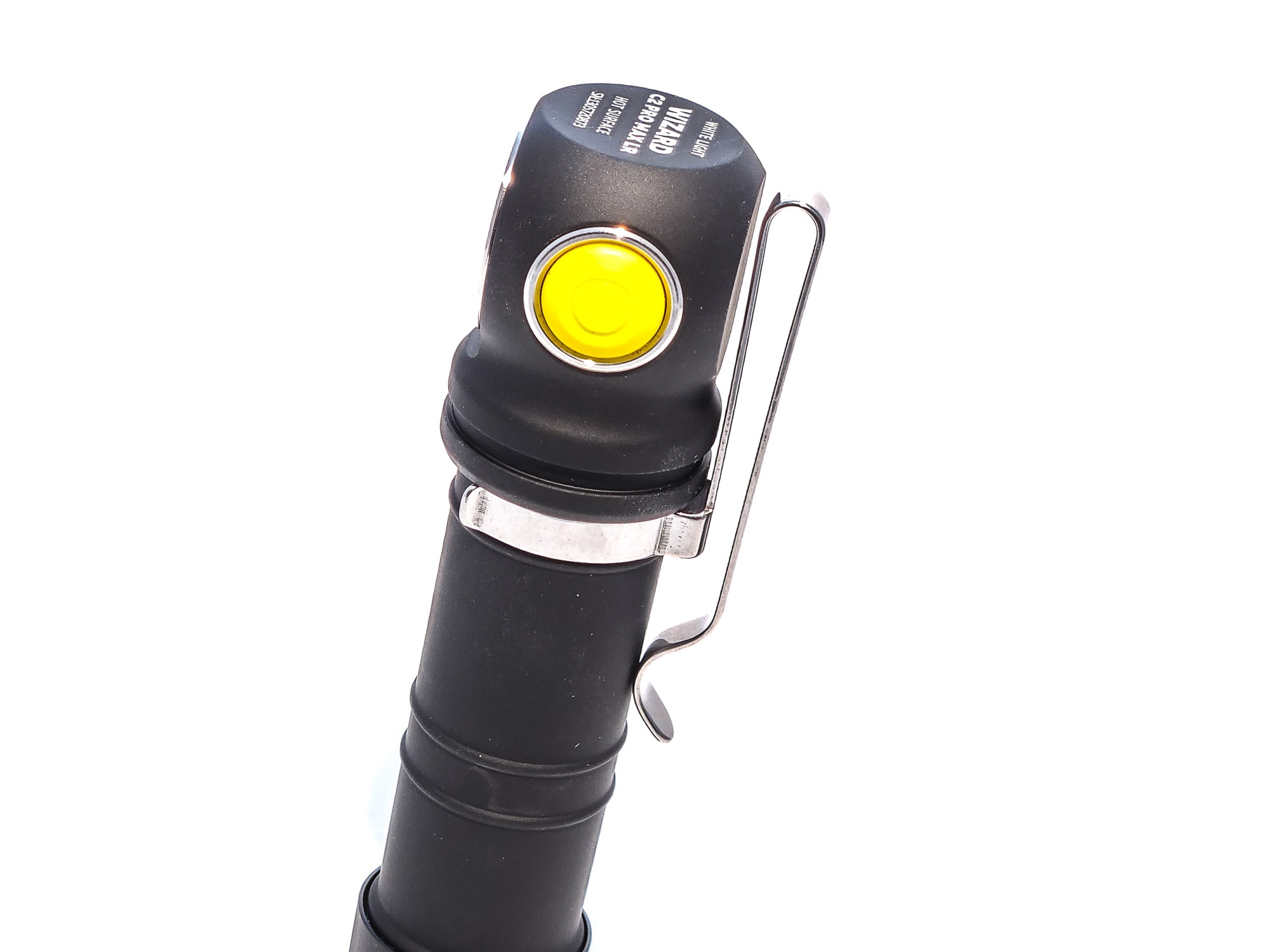
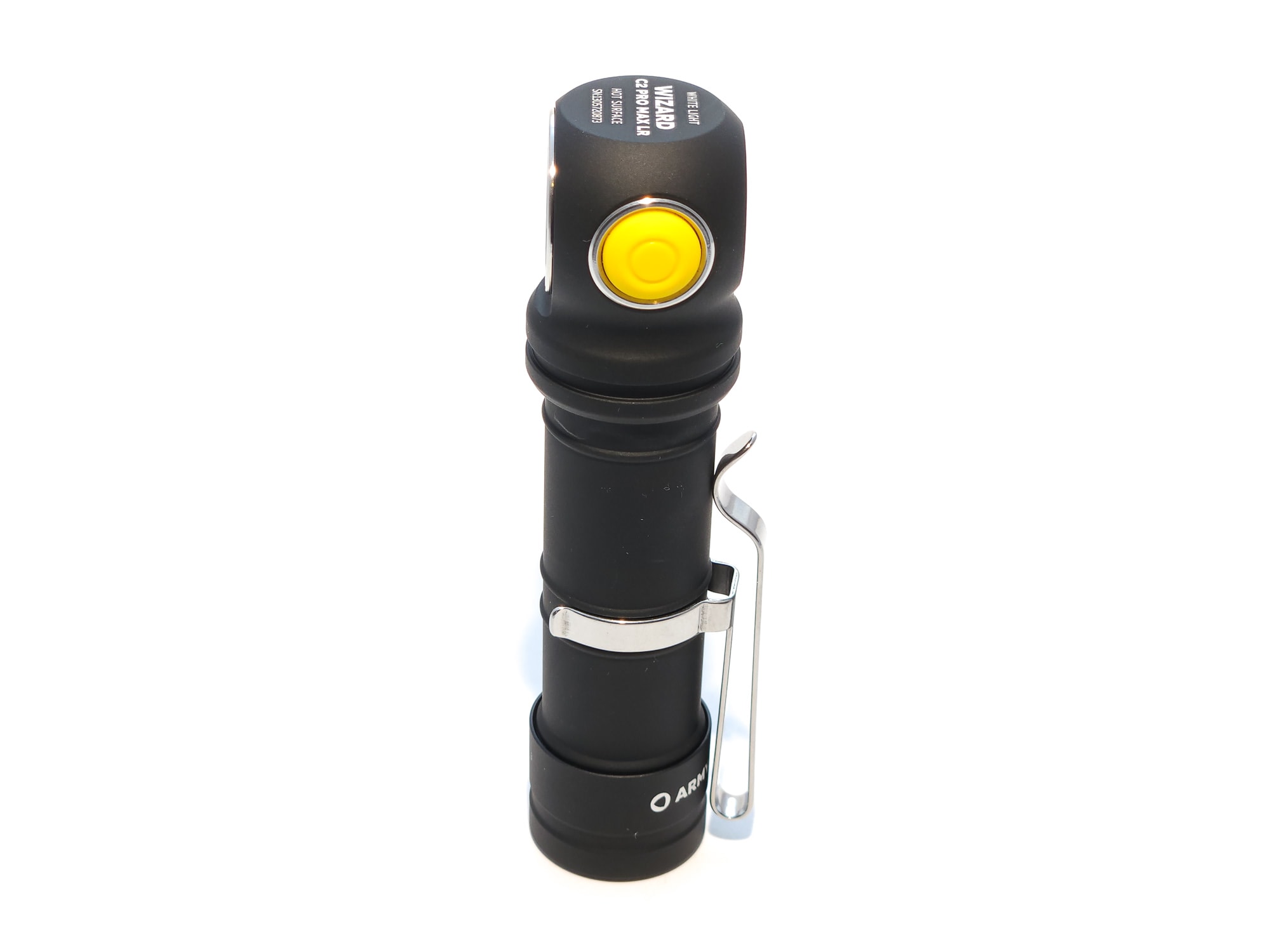
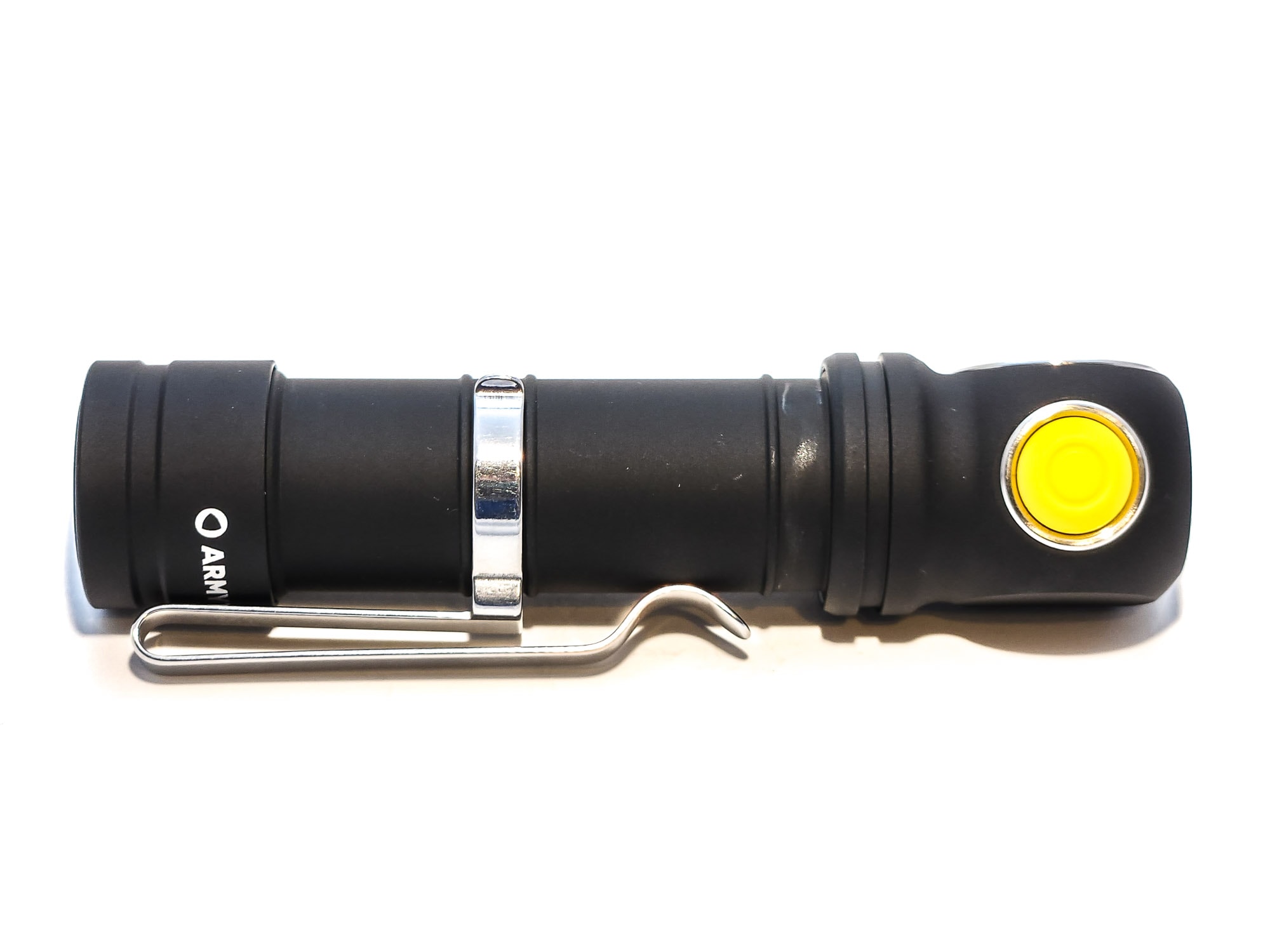
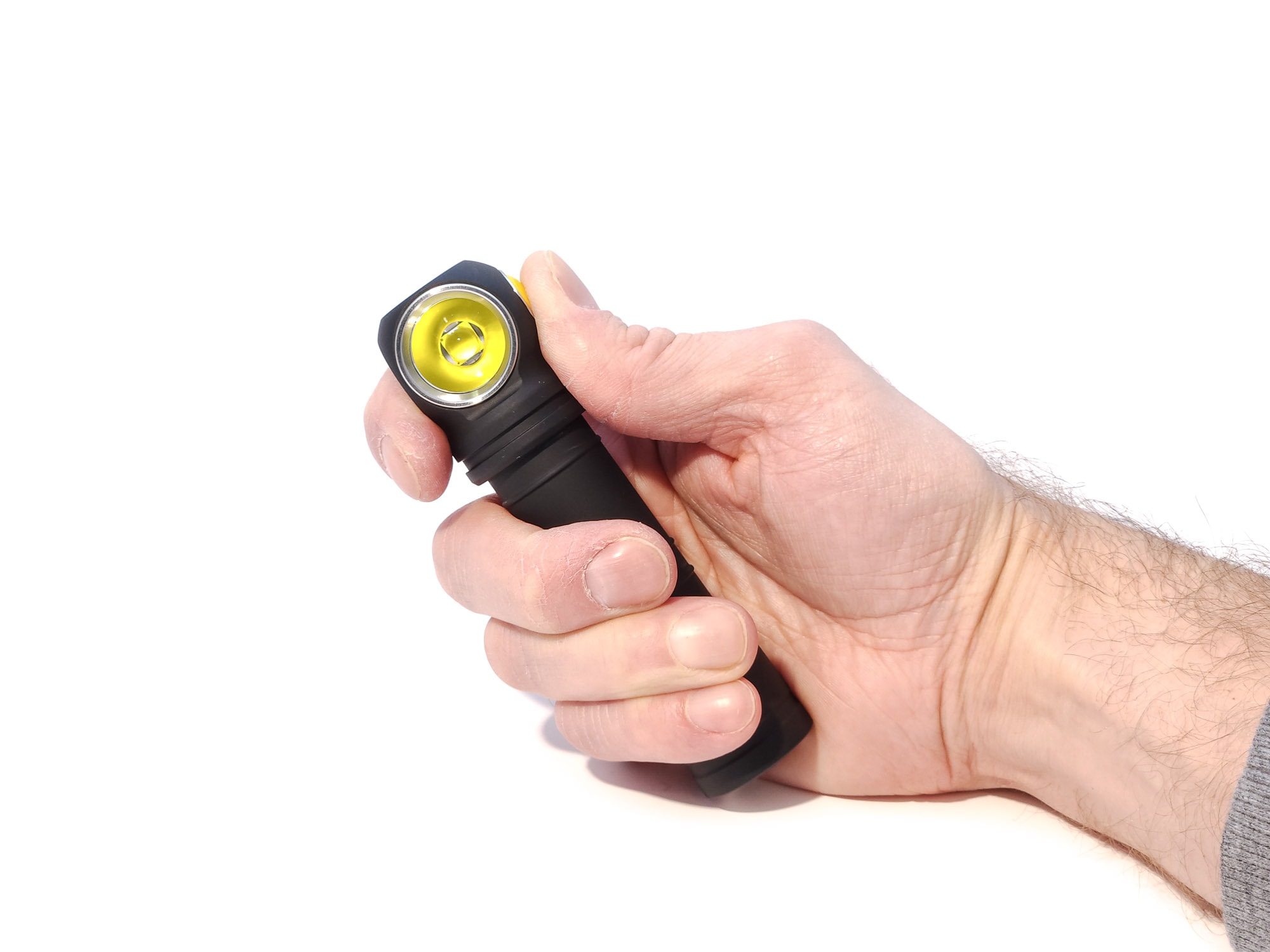
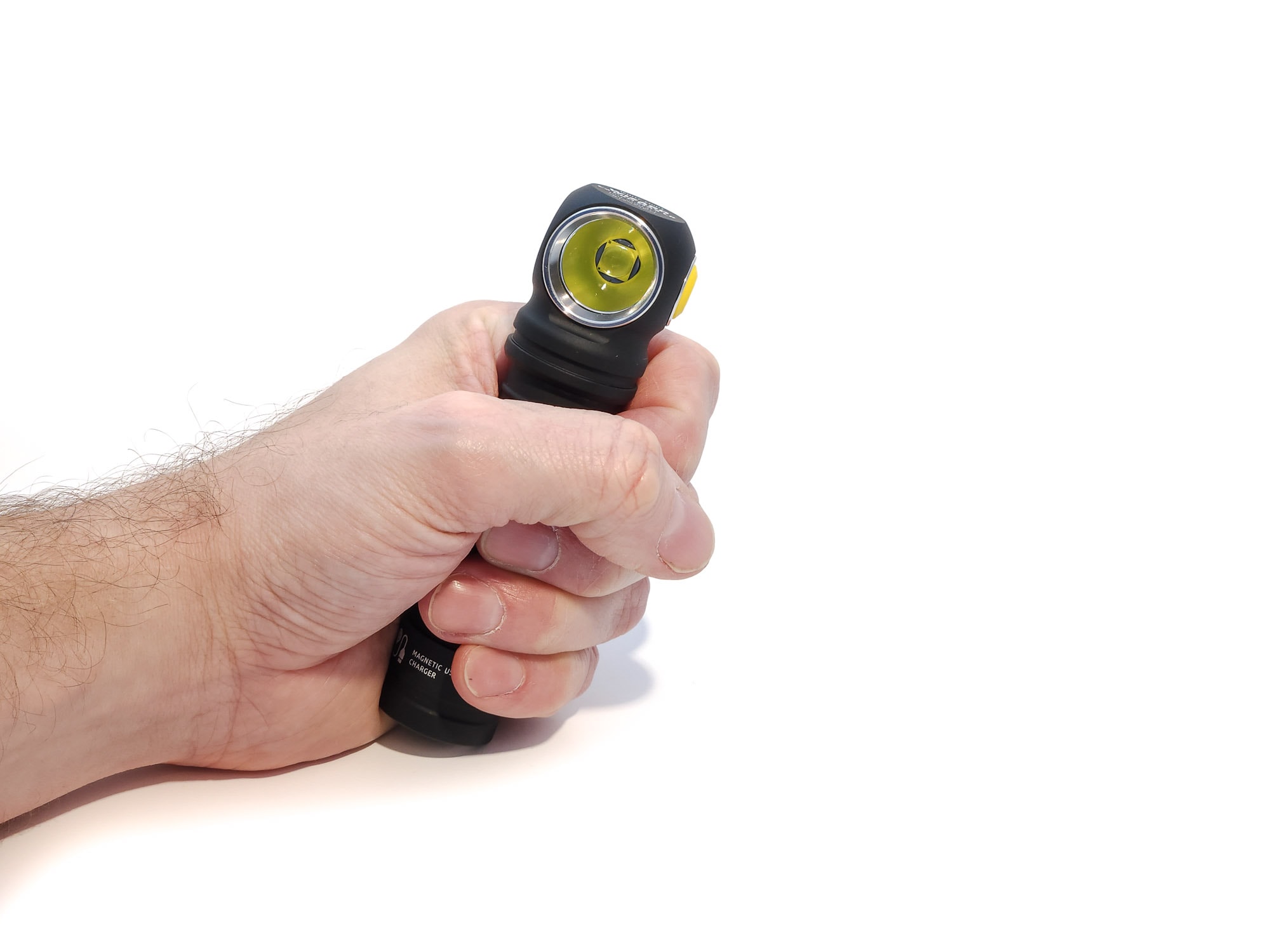
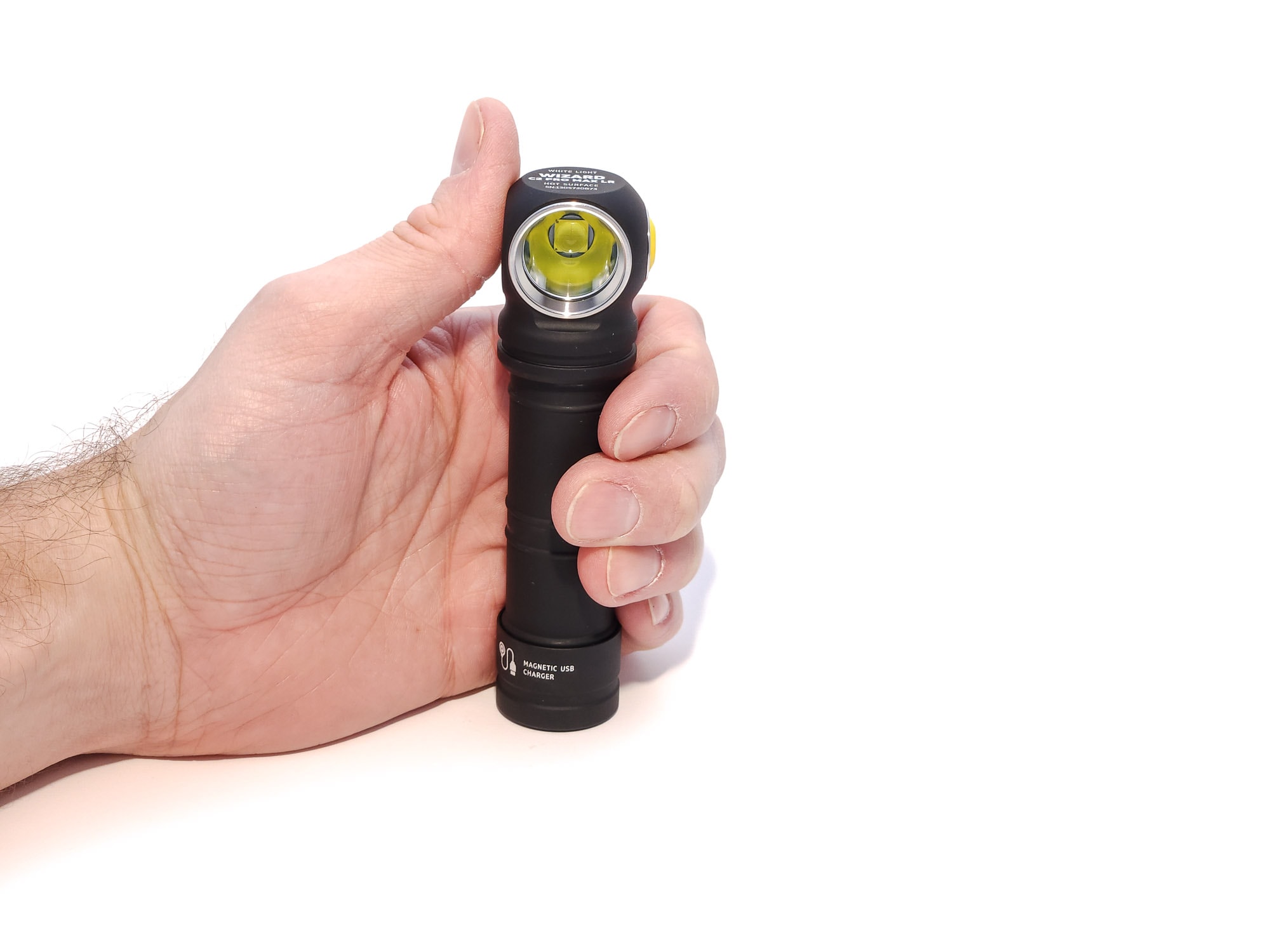
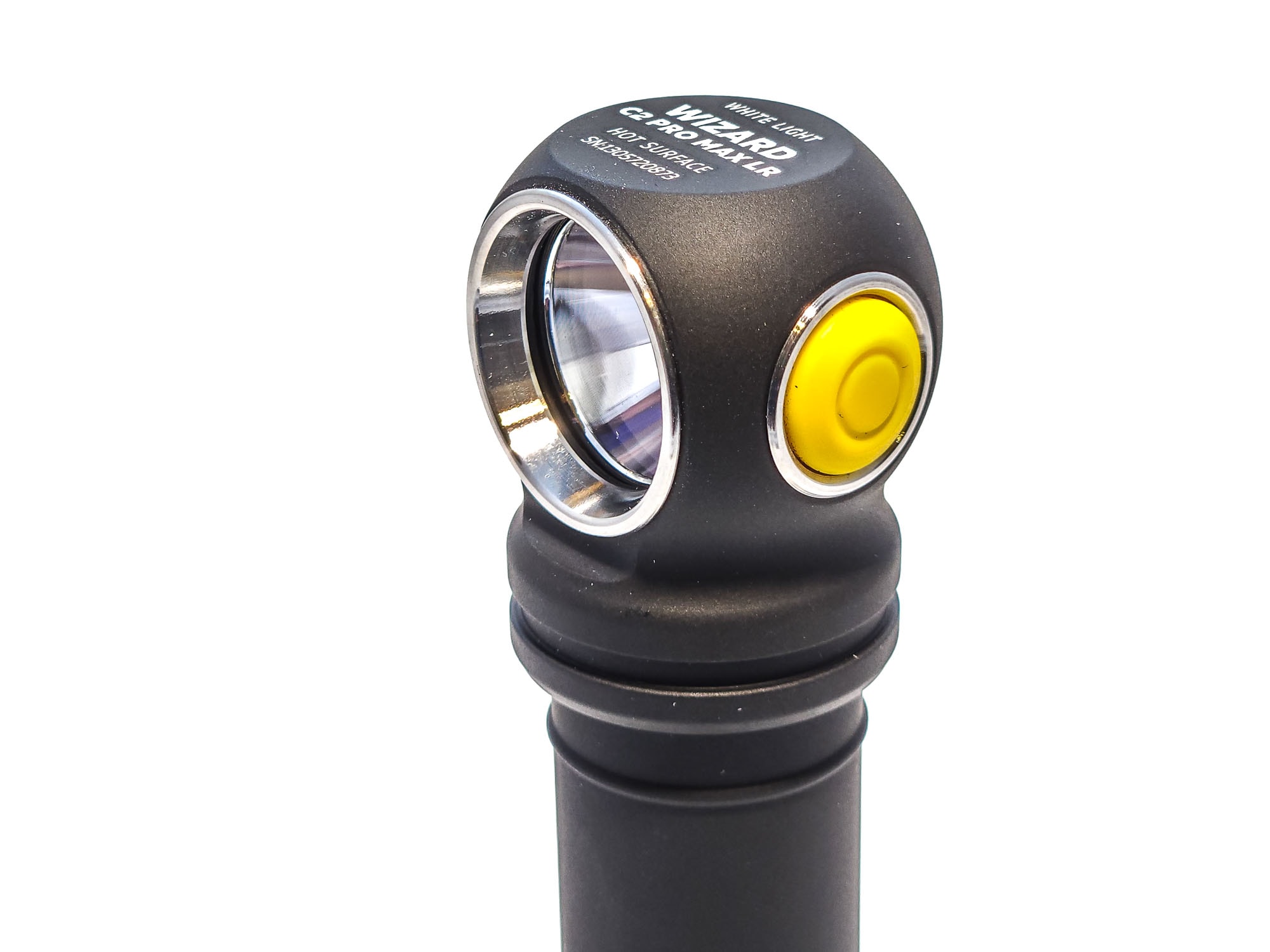

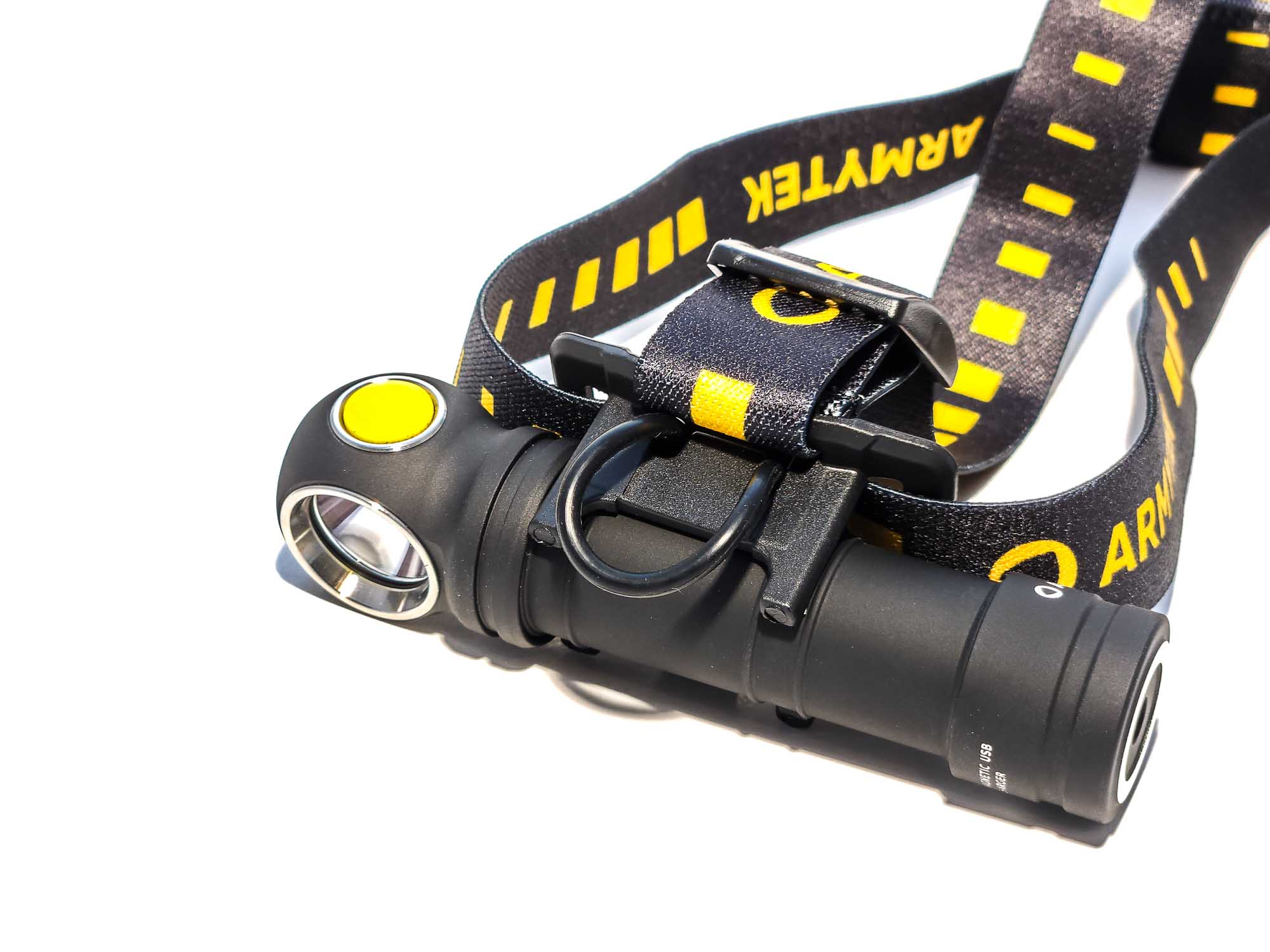
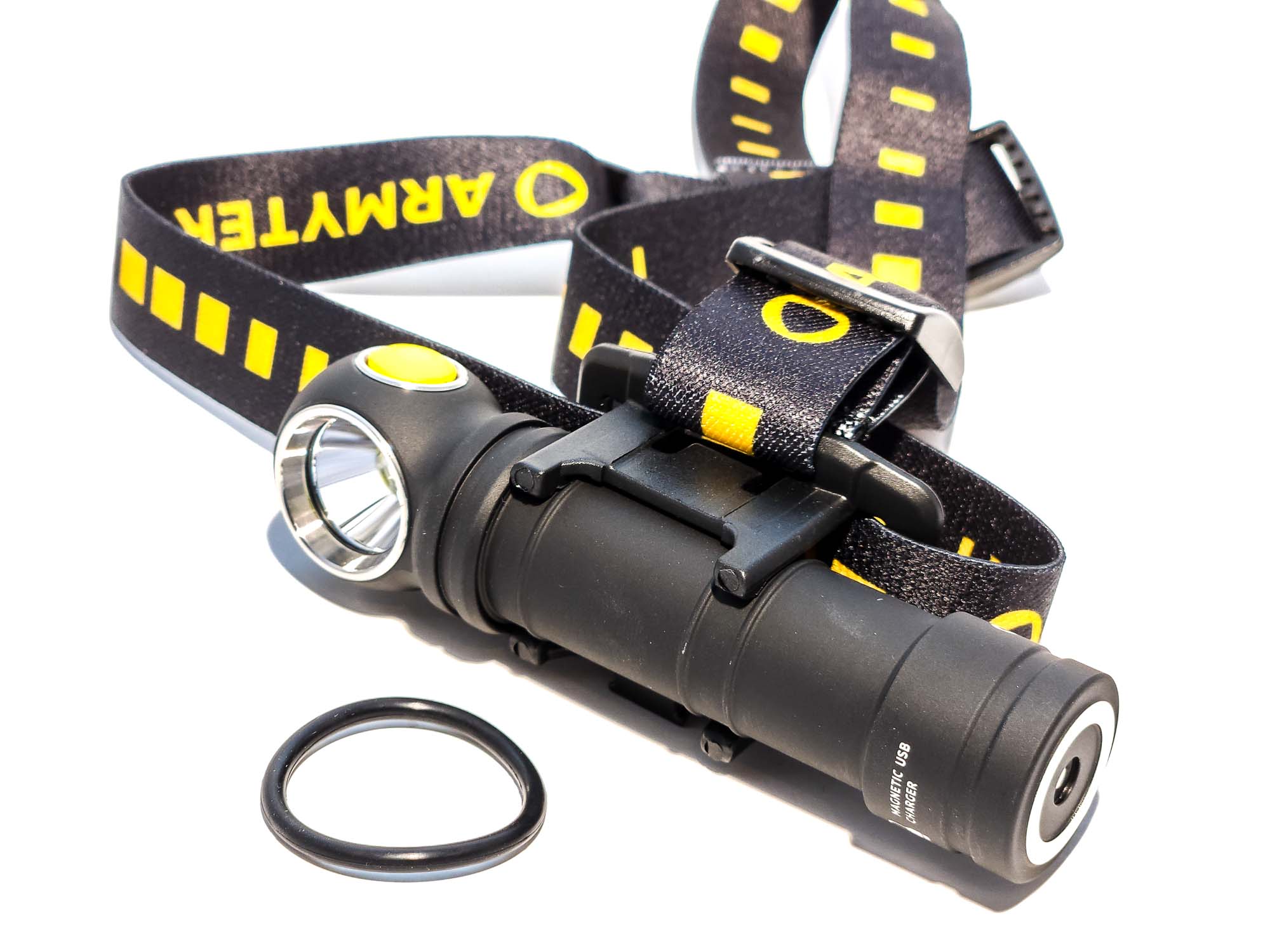
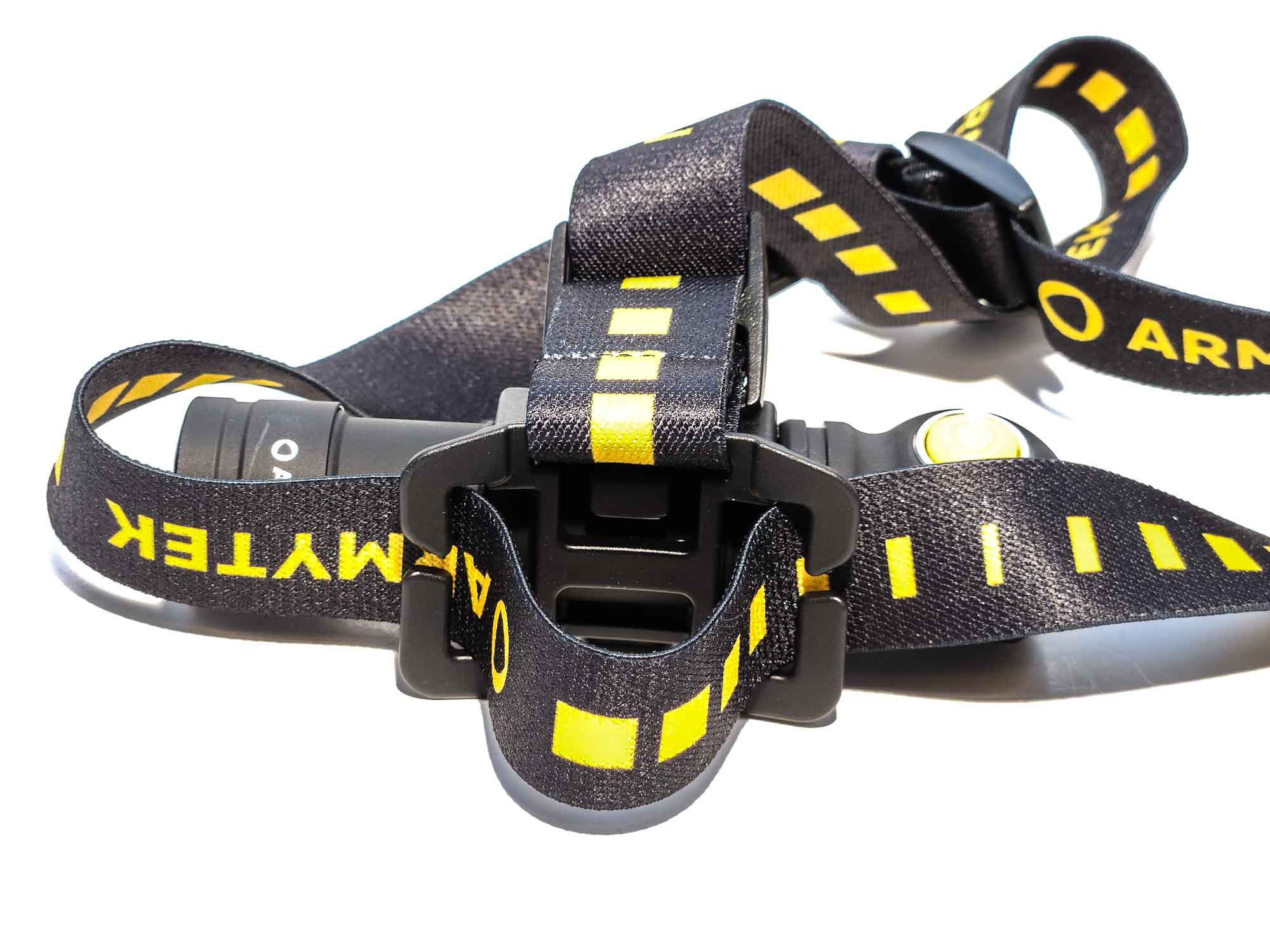
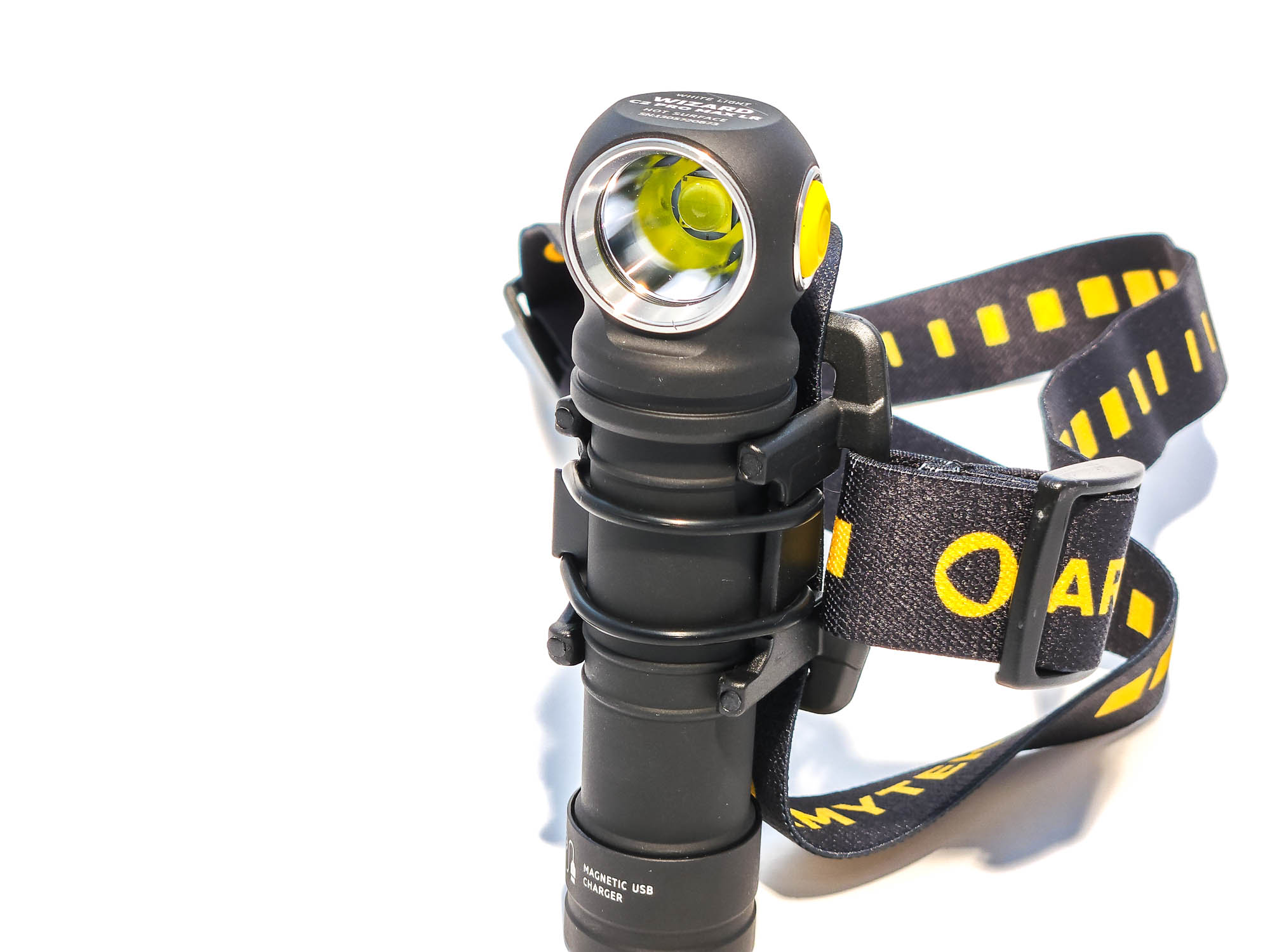
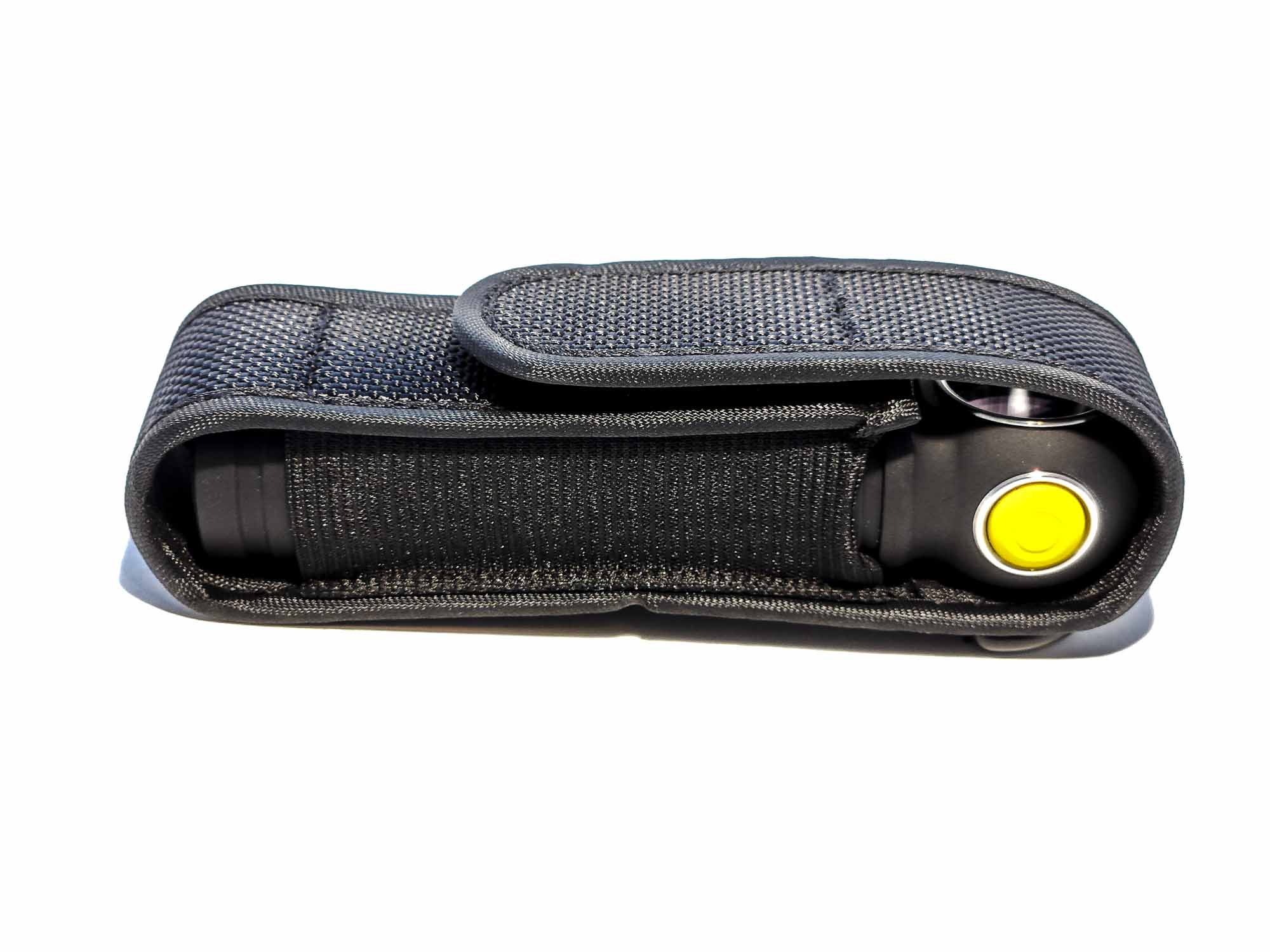
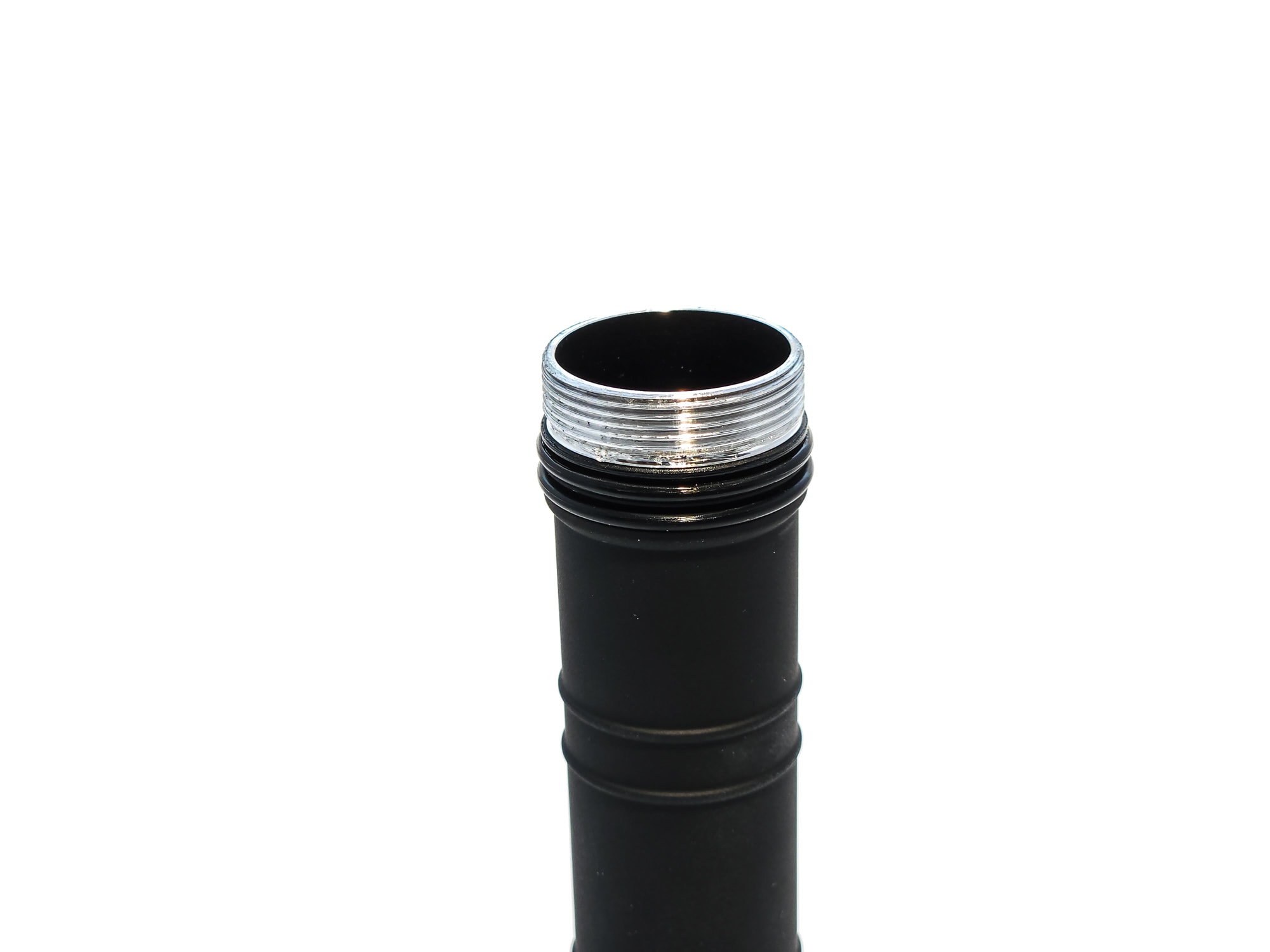
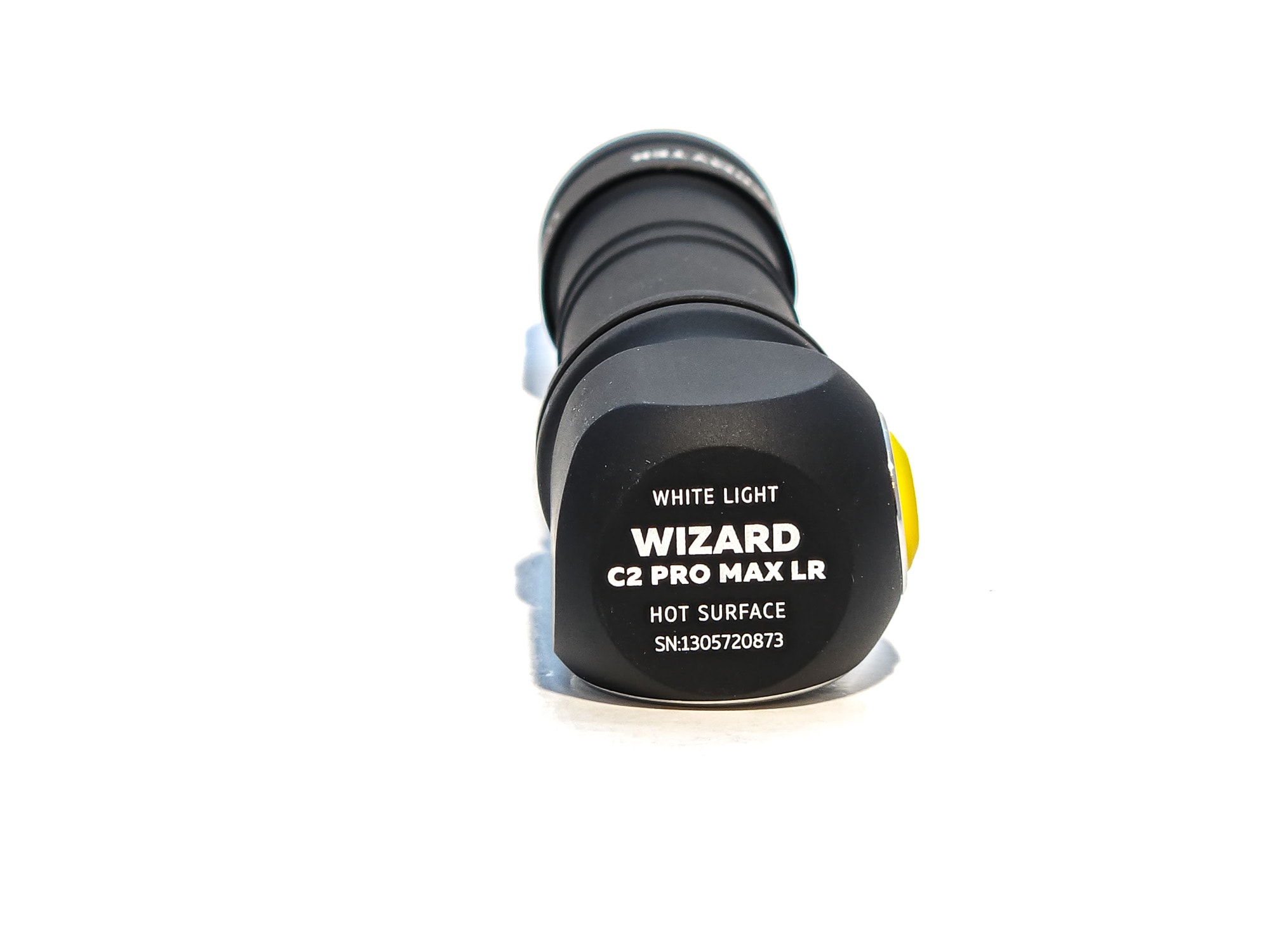
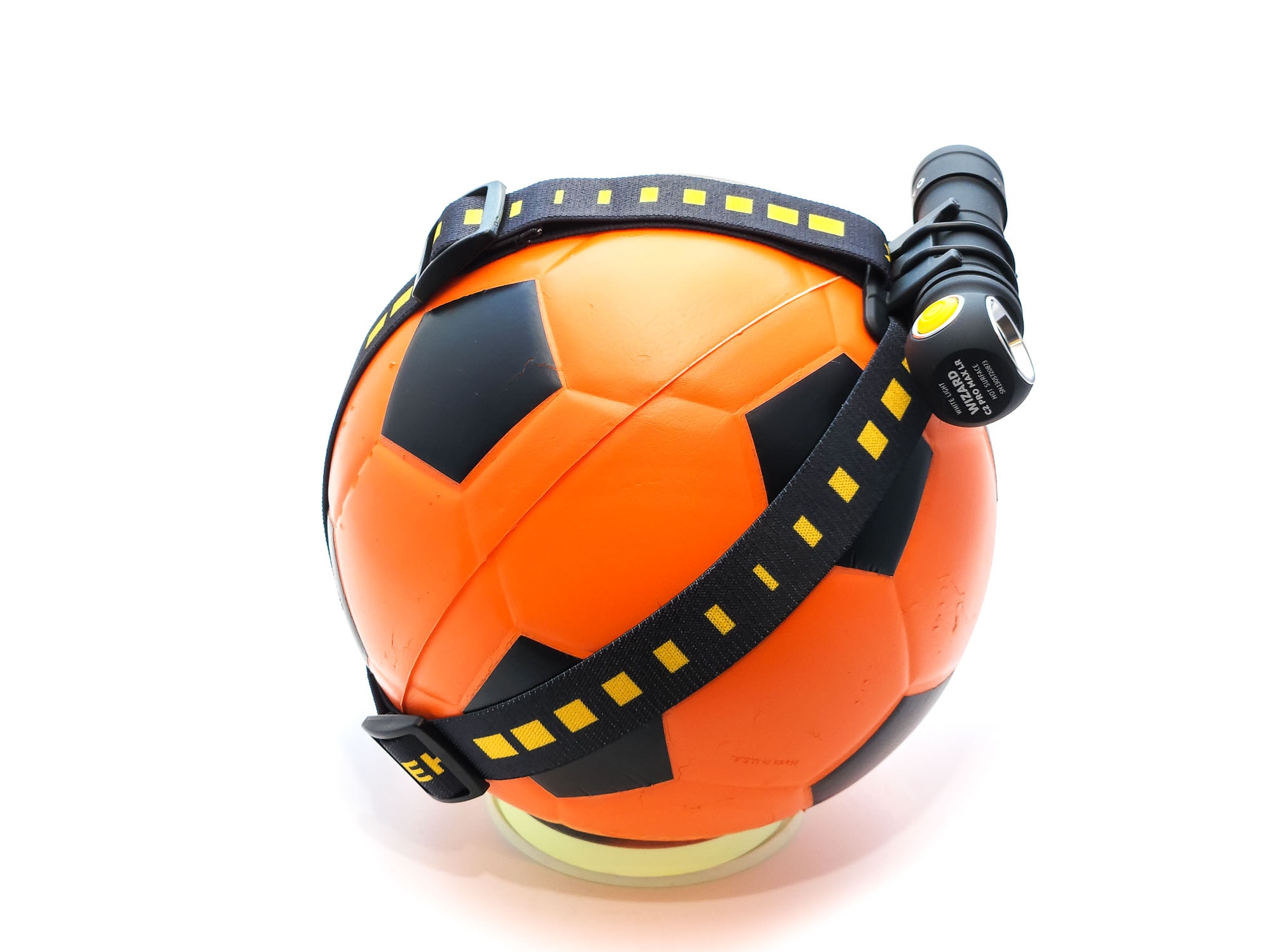
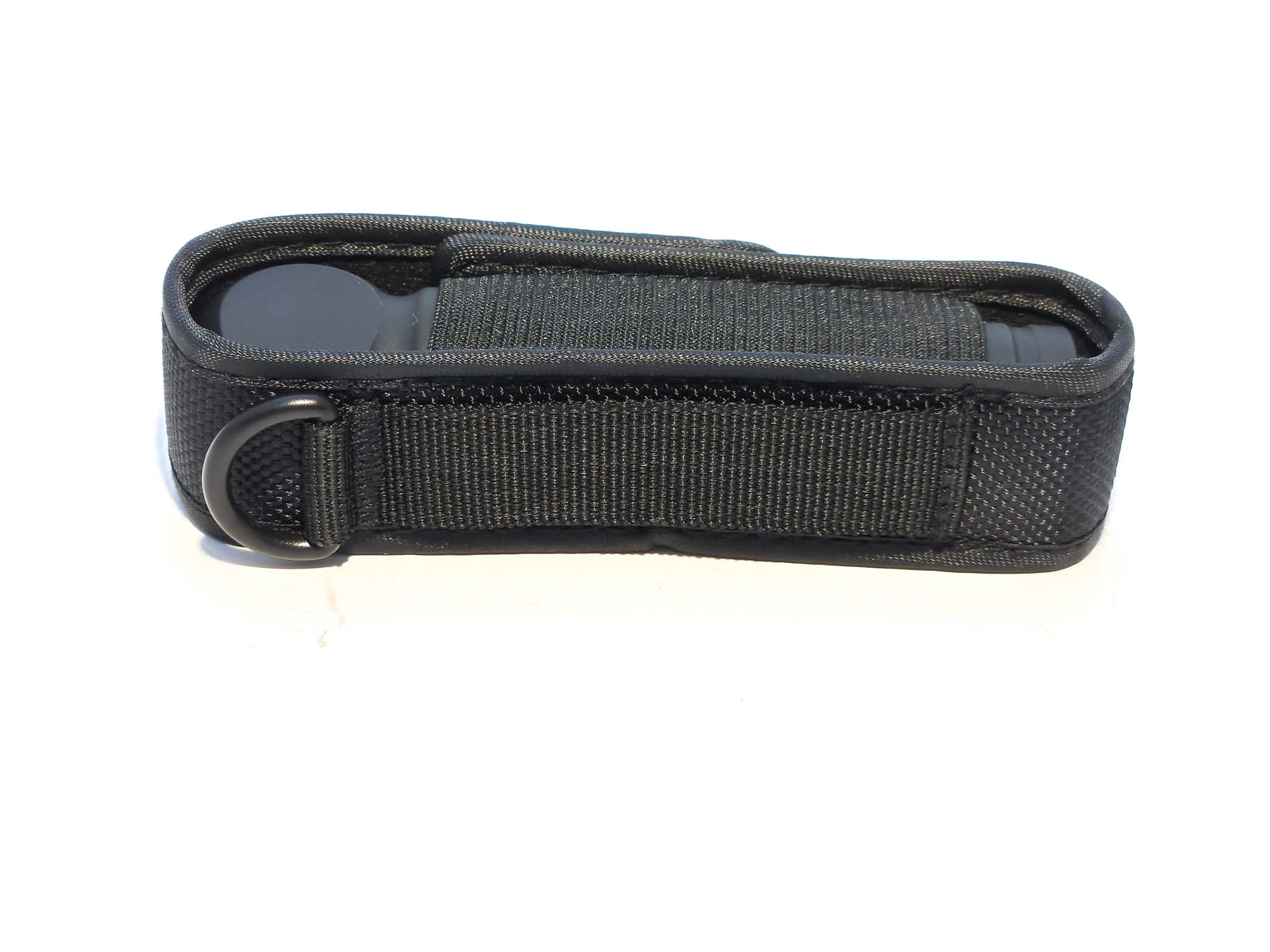
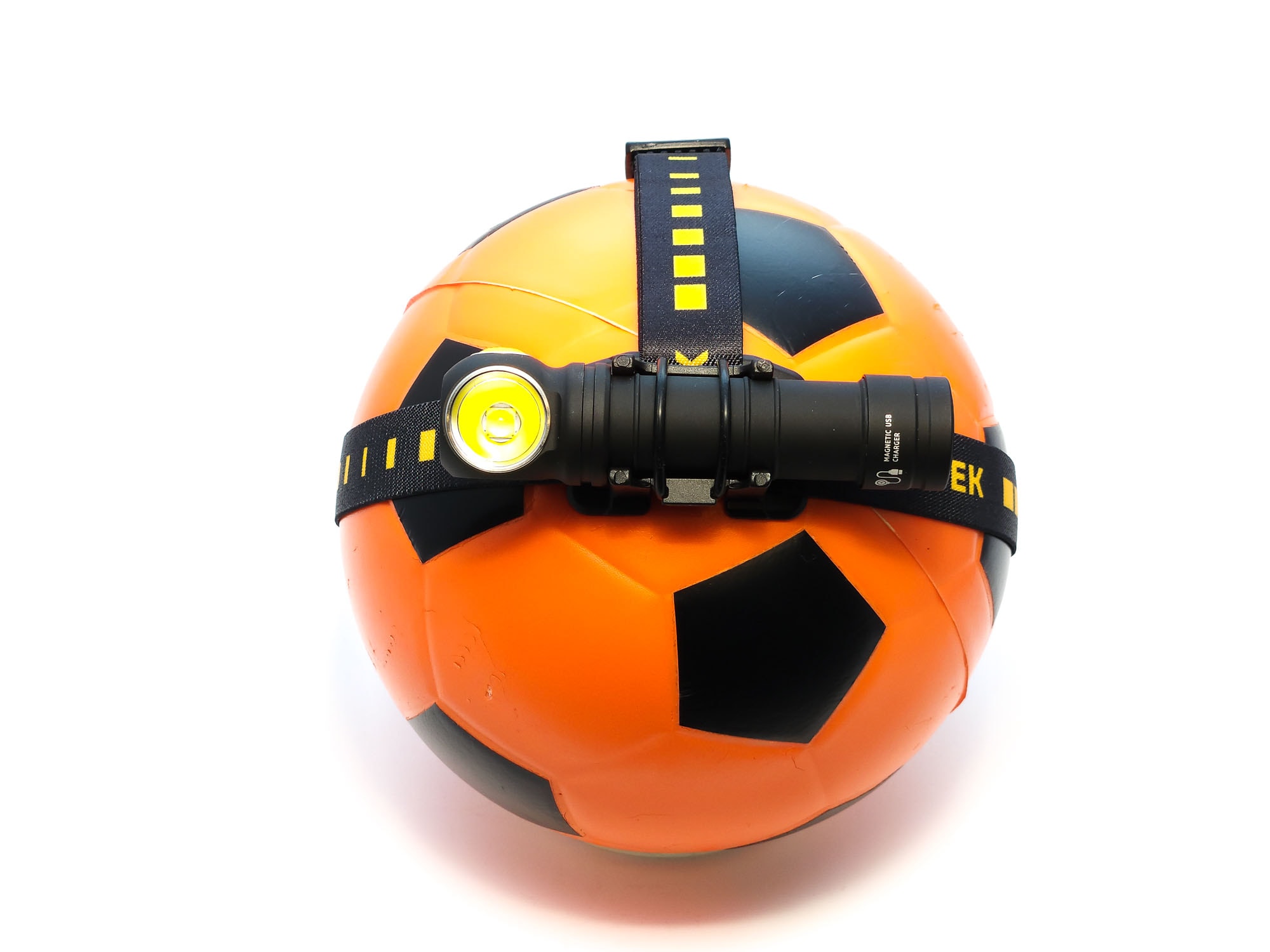
LED, Lens, Bezel, Beam, and Reflector
Pro models of the Wizard use a 6V emitter and in this case it’s the Cree XHP70.2 in cool or warm white. My review sample is the cool white version which offers higher output and further throw than the warm white version so keep in mind that the figures and measurements in this review will be higher than that.
The XHP70.2 is the domed HD (High Density) version. It would’ve been interesting to see the XHP70.3 HI (High Intensity) domeless version used, which would have even more throw. Either way, the XHP70 is a powerful, quad-die emitter. The beam is very white, though it does have the typical Cree yellow tint towards the edges. Firefly1 (0.6 lumens) is low enough that you can look directly at the emitter and even make out the four dies. You will probably note that they are not all exactly the same brightness, and this is not unusual for a multi-die emitter. It does not indicate any problems, and you will only ever notice it on the lowest mode.
In order to make this a long range light, Armytek replaced the TIR optics in other Wizards with a smooth reflector. It’s a pretty short reflector, but that’s limited by the size of the head given that it’s a headlamp. However, Armytek also engineered the bezel to follow the contour of the reflector, acting as an extension. Even with that, the length of the reflector does make the light floodier than you’d expect, with an advertised 35-degree hotspot with 85-degree spill. The reflector is covered by an anti-reflective coated, tempered glass lens and pressed into place with a smooth bezel.
Spectral measurements:
I used an Opple Light Master Pro to measure the flashlight at 1 meter.
| Mode: | CCT: | CRI Ra: | duv |
|---|---|---|---|
| Turbo2 | 6282K | 72.7 | -0.0016 |
As expected, the XHP70.2 is cool and has low CRI, but that doesn’t mean it doesn’t look good! That negative DUV score indicates that it’s got a very white beam when you’re blasting it on turbo.
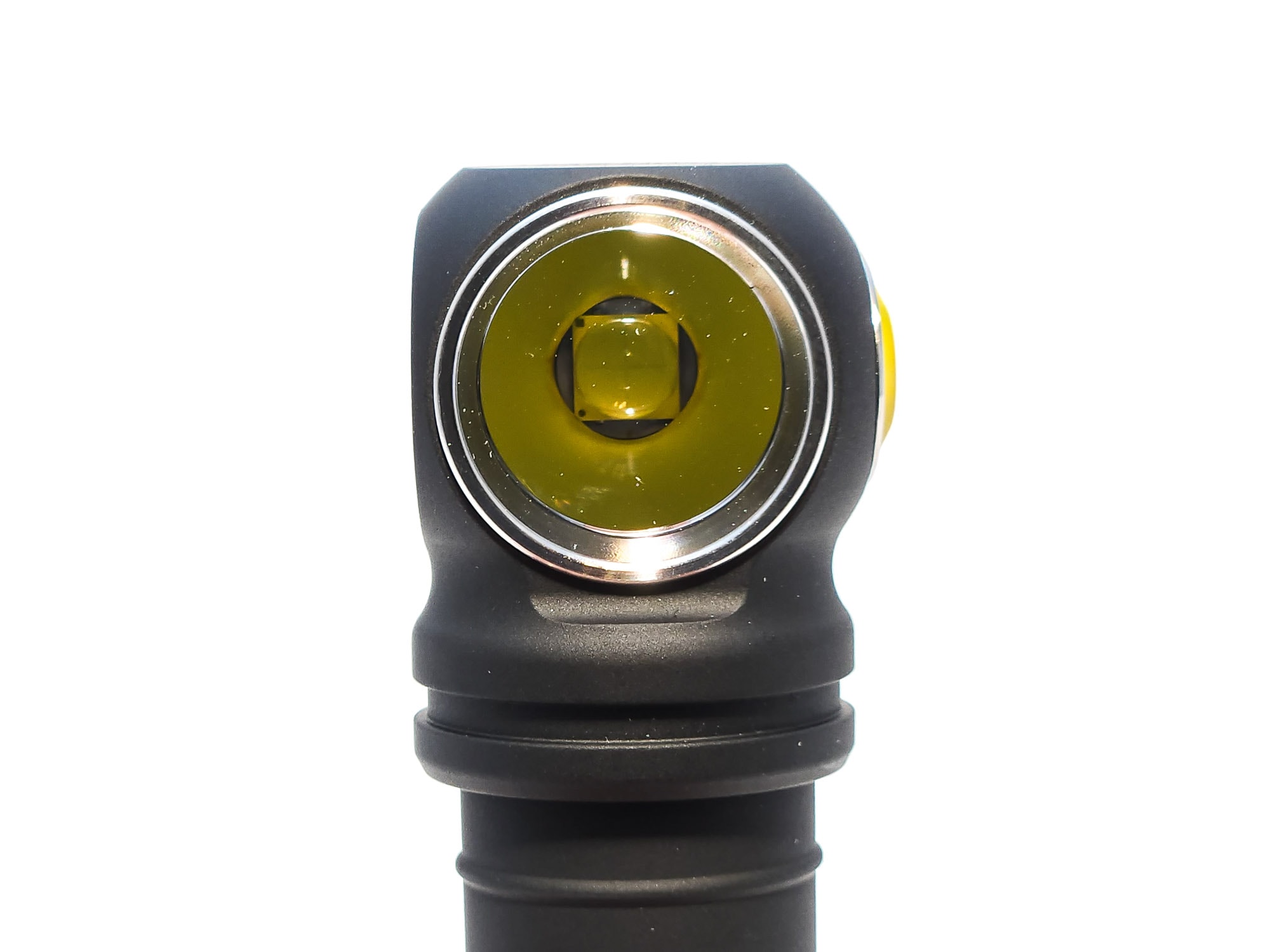
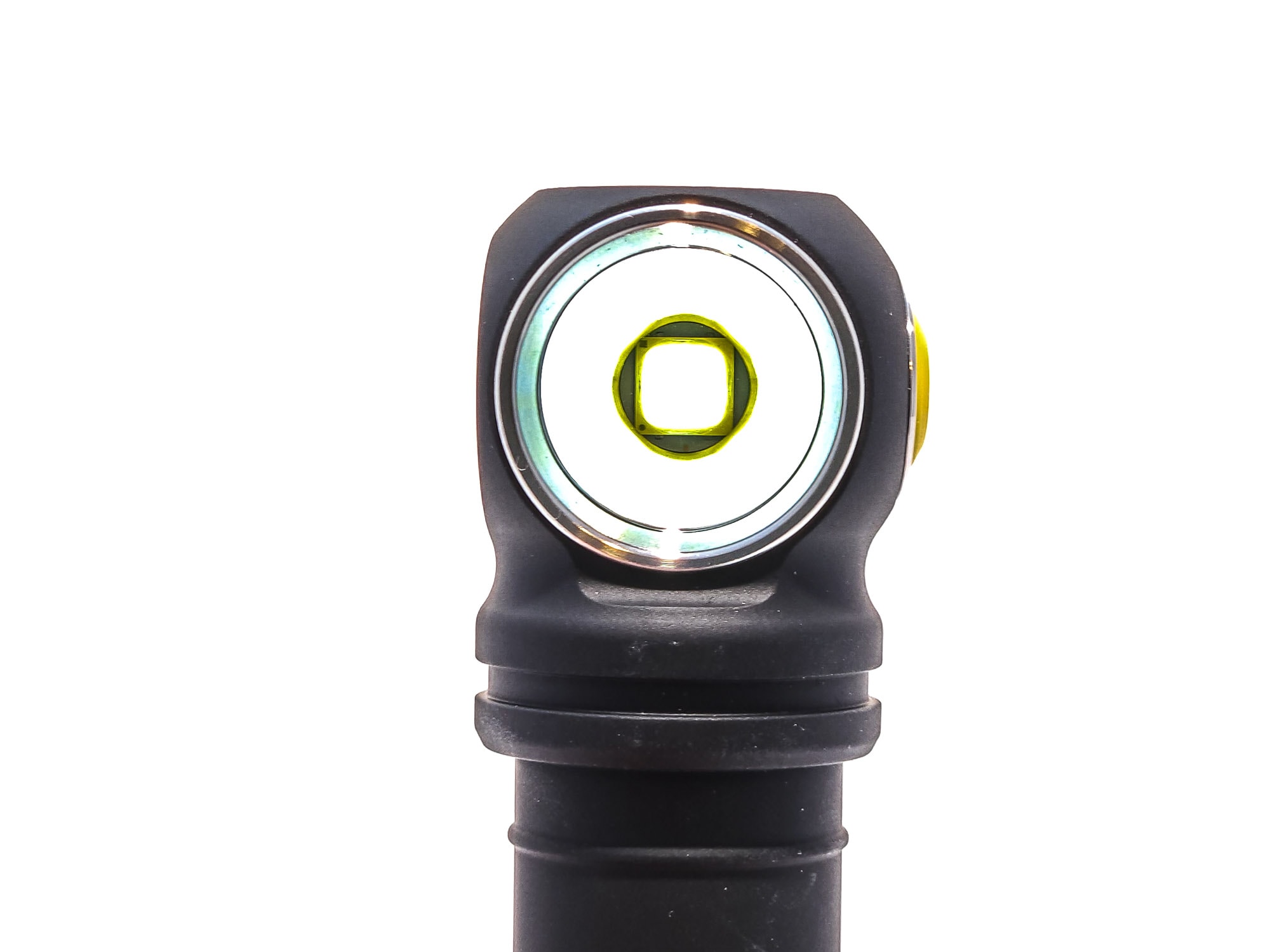
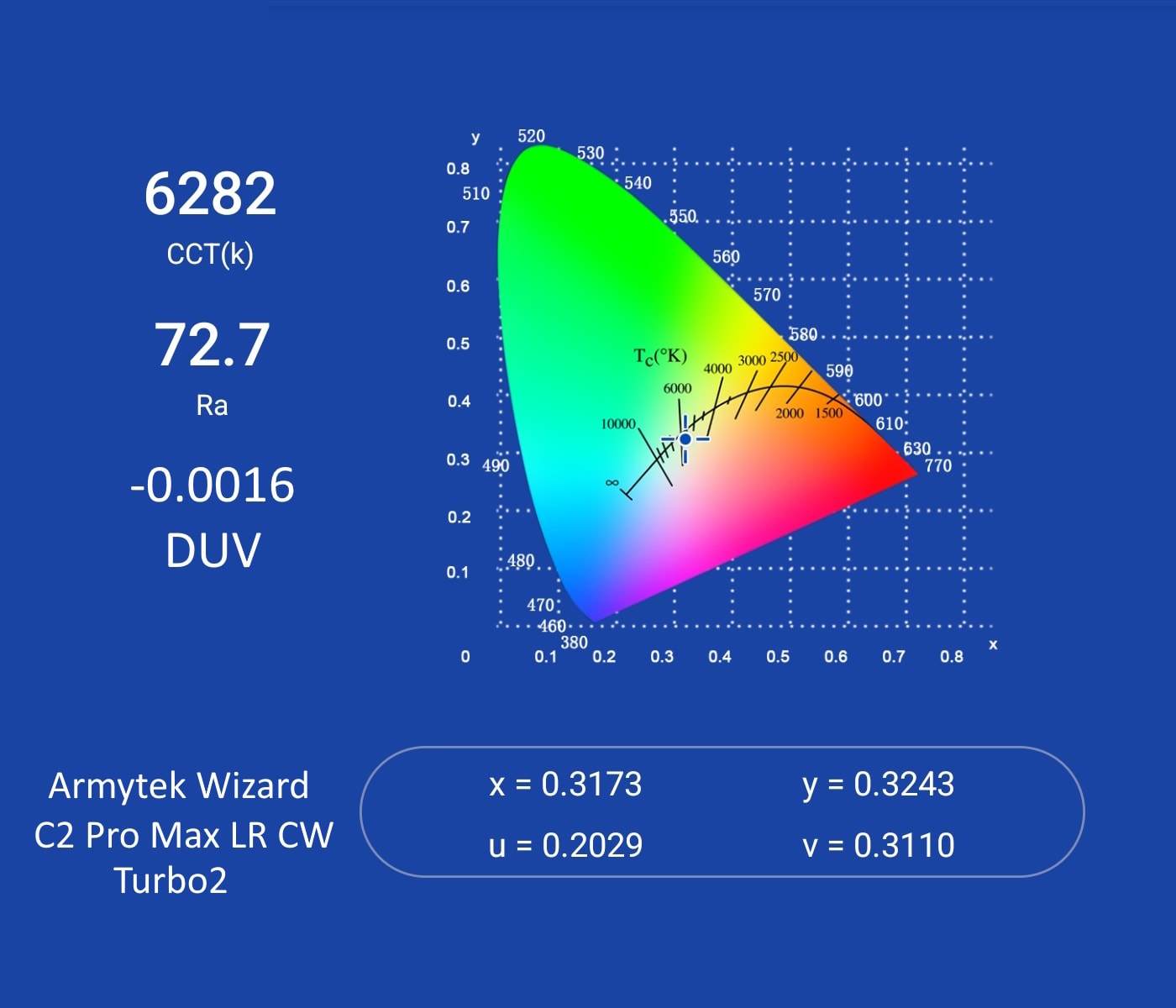
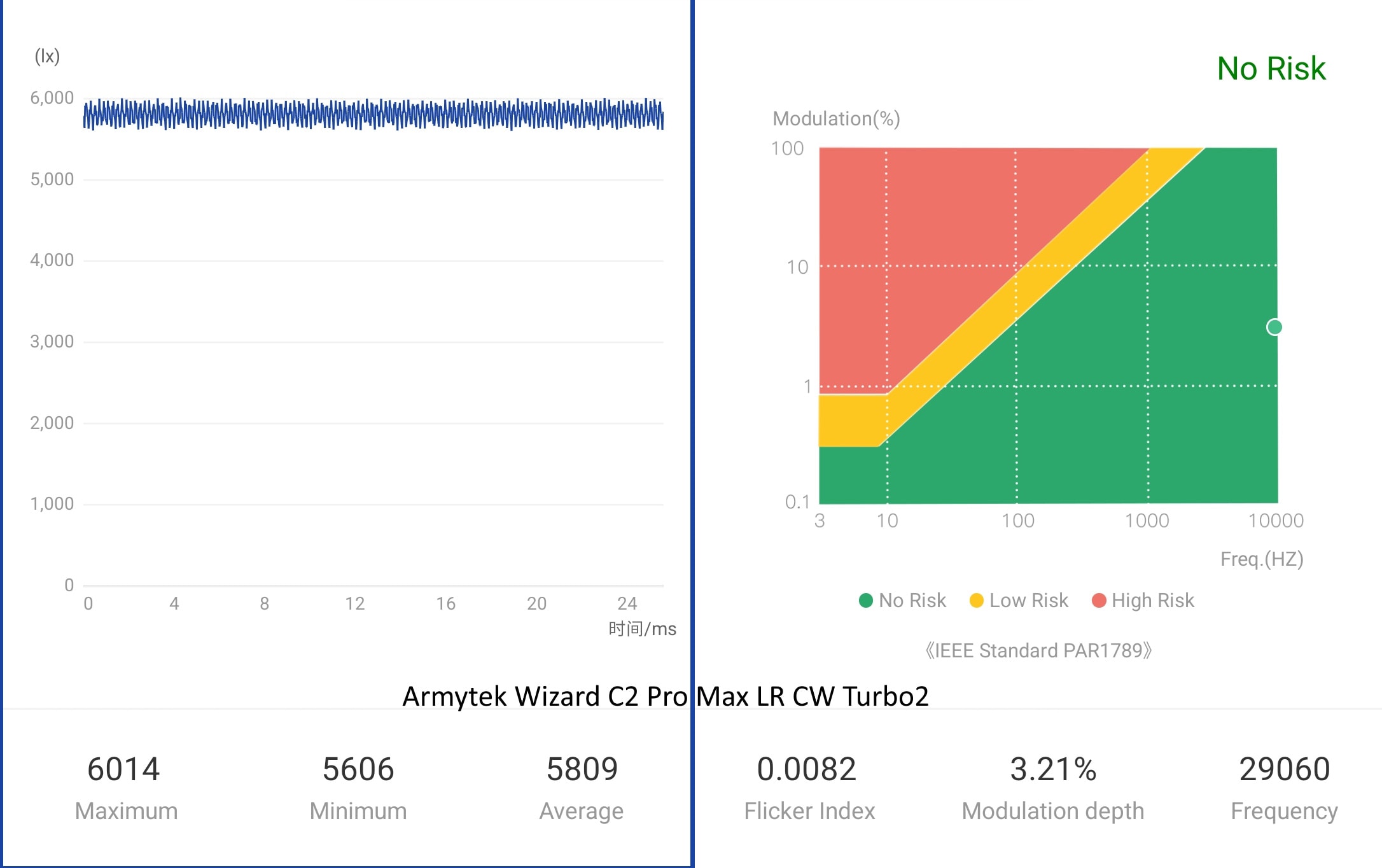
Dimensions and its competition
If you’re looking at a 21700 headlamp, you should already know that it’s going to be long and heavy.
Dimensions:
| Wizard C2 Pro Max LR | Millimeters | Inches |
|---|---|---|
| Length | 121 mm | 4.8 in |
| Head diameter | 32 mm | 1.3 in |
| Body diameter | 24 mm | 0.9 in |
Dimensions are rounded to the nearest millimeter and the nearest tenth of an Inch.
Weight:
| Wizard C2 Pro Max LR | Weight in grams | Weight in oz |
|---|---|---|
| Without battery: | 81 g | 2.8 oz |
| With battery | 150 g | 5.3 oz |
Weight is rounded to the nearest gram and tenth of an Oz.
Flashlight size comparison with its competition:
Group 1: Armytek Wizard C2 Pro Max LR, Skilhunt H300, Emisar D4, Thrunite Thrower
Group 2: Emisar D4V2, Armytek Wizard C2 Pro Max LR, Convoy S2+
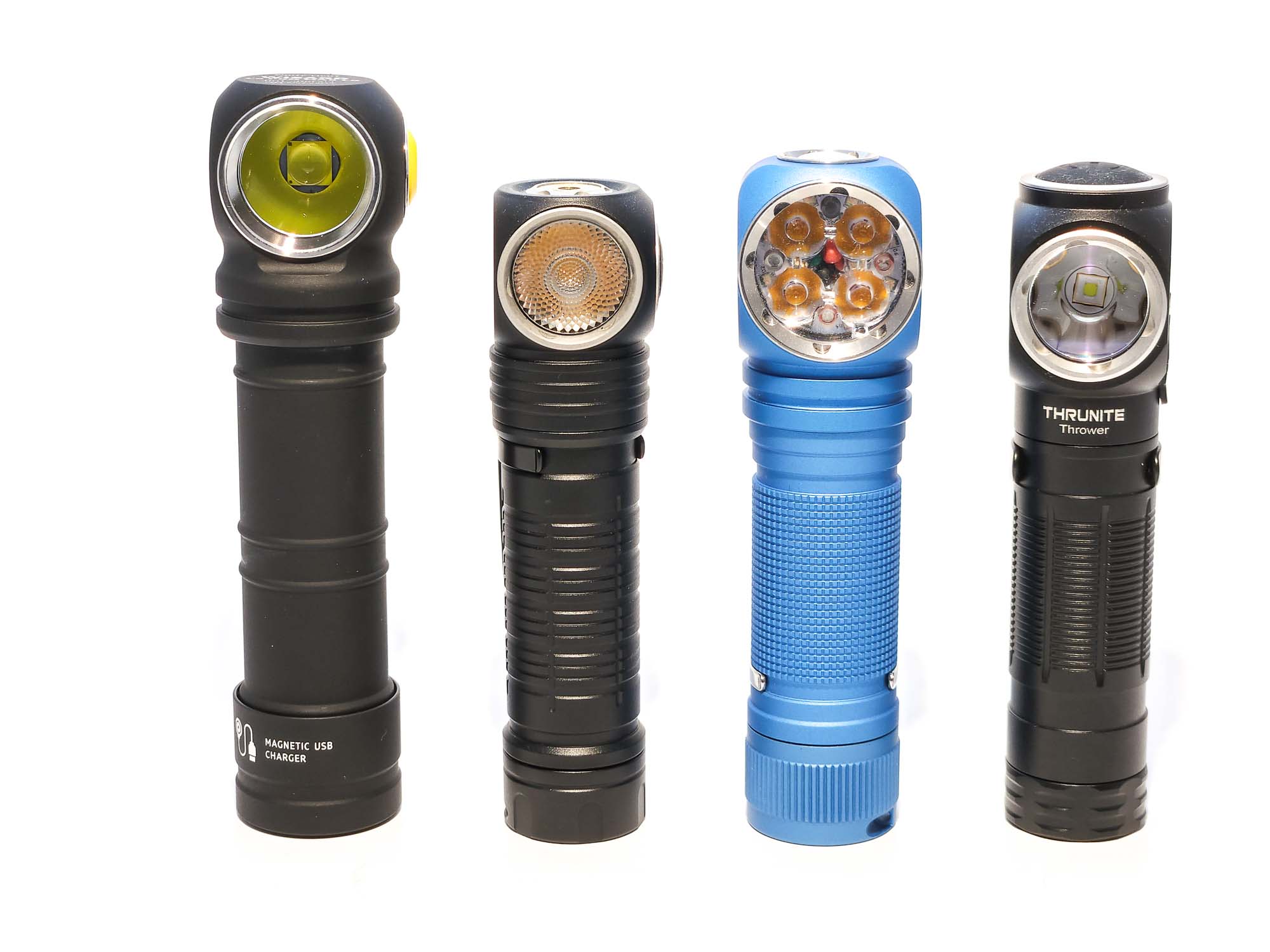
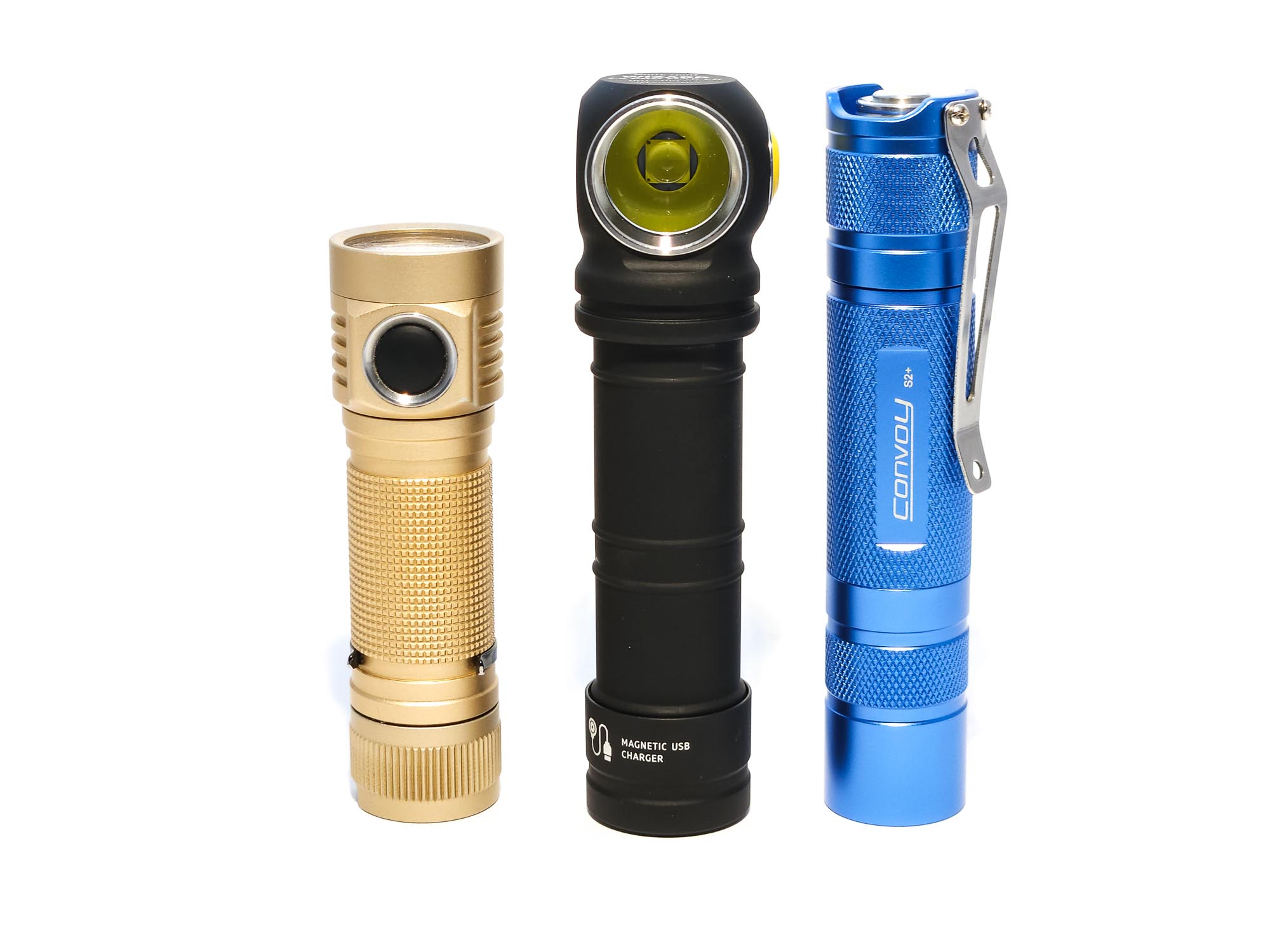
Armytek Wizard C2 Pro Max LR UI: User Interface and Driver
Armytek has a UI which is fairly straightforward, though it does come in two parts. The light ships in the “General Type” mode, but you can switch between that and the “Advanced Type” mode by unscrewing the tail cap enough to disconnect it, holding the button down, and screwing the tail cap back on.
Full user manual: here
Available modes:
- Firefly1, Firefly2, Main1, Main2, Main3, Turbo1, Turbo2
Available blinky modes:
- Strobe1, Strobe2, Strobe3
General Type mode
From OFF:
- Press and hold: On to Firefly1, then cycle up through modes. Firefly will advance to Main, but when in Main, it will only cycle through Main: F1, F2, M1, M2, M3, M1, M2, M3, etc.
- Single click: On to memorized mode
From ON:
- Press and hold: Cycle through modes. Firefly will advance to Main, but when in Main, it will only cycle through Main: F1, F2, M1, M2, M3, M1, M2, M3, etc.
- 1 click: Off
- Double click: Turbo2
Advanced Type mode
From OFF:
- Press and hold: On to Firefly1, then cycle up through modes: F1, F2, M1, M2, M3, T1.
- Single click: On to last used mode
- Double click: On to memorized Main mode
- Triple click: On to memorized Turbo mode
- 4 clicks: On to memorized Strobe mode
From ON:
- Press and hold: Cycle through modes within the same group:
- F1 and F2
- M1, M2, and M3
- T1 and T2
- S1, S2, or S3
- 1 click: Off
- Double click: Switch to memorized Main mode
- Triple click: Switch to memorized Turbo mode
- 4 clicks: Switch to memorized Strobe mode
Mode memory:
- General
- The last used mode will be memorized
- Advanced
- The last used mode in each group will be memorized
- The last used mode will be memorized and accessed through a single click to turn on. This includes turbo and strobe!
Shortcuts:
- To Low: Hold from off
- To Turbo:
- General: Double click from on
- Advanced: Triple click
- To Strobe: 4 clicks in Advanced only
Low voltage warning/protection:
- The indicator light in the button will blink orange under 25% battery power and red under 10%.
- The emitter will also blink twice when the output drops to 25%
High temperature warning
- When the temperature increases to the warning level, the color LED flashes orange 3 times once in 2 seconds. At critical level it flashes red 3 times once in 1 second. Brightness starts to reduce to safe level.
Strobe/blinkies
- Four clicks from either on or off in Advanced Type will get you to strobes. They are:
- 1Hz 150 lumens
- 1Hz 4000 lumens
- 10Hz 4000 lumens
Lock-out mode:
- There is no electronic lockout, but you can unscrew the tail cap to disconnect it
PWM
- There is no visible PWM.
Additional/summary info on the UI:
- It may seem complicated when it’s written out like this, but it’s actually pretty straightforward when you’re using it.
Armytek Wizard C2 Pro Max LR Charging and batteries
Armytek includes their proprietary magnetic charger with the Wizard. It appears to be a 1A charger, as they advertise it takes 5 hours and 20 minutes to charge the included 5000mAh battery. I had different experiences with different chargers, though. With a 2A charger, the button light was orange, indicating insufficient current, and it took 9.5 hours to charge. With a 3A charger, the light was green and it finished in just over 5 hours. That’s a pretty long charge time, but a slower charge is better for the battery, so it’s kind of a trade off. Charging tops out at about 4.15V.
In order to enable charging, you have to unscrew the tail cap 1/4 turn. If it’s not unscrewed, the charger will blink red to remind you. Because of that, you cannot use the light while it’s on the magnetic charger.
The battery is a standard flat top 21700, so you can also take it out and charge it in a regular charger at whatever current it uses. I’d prefer to do this unless I was on the go, due to the charging speed.
I did not observe any low voltage protection on the Wizard during testing. It dropped to Firefly1 mode, but stayed there until I stopped it, 24 hours after the test started. At that time, the battery was at 2.85V. Based on my tests, I believe when the output drops to sub lumen, the battery is around 3V.
In a 250mA capacity test using my Vapcell S4+ charger, the battery was rated at 4688mAh. Not quite the 5000 that was advertised…
| Charge type | Fits | No fit | Charge time |
|---|---|---|---|
| Flashlight with onboard USB-C | All 21700 sizes; all 18650 sizes (with adapter) | N/A | 5 hours |
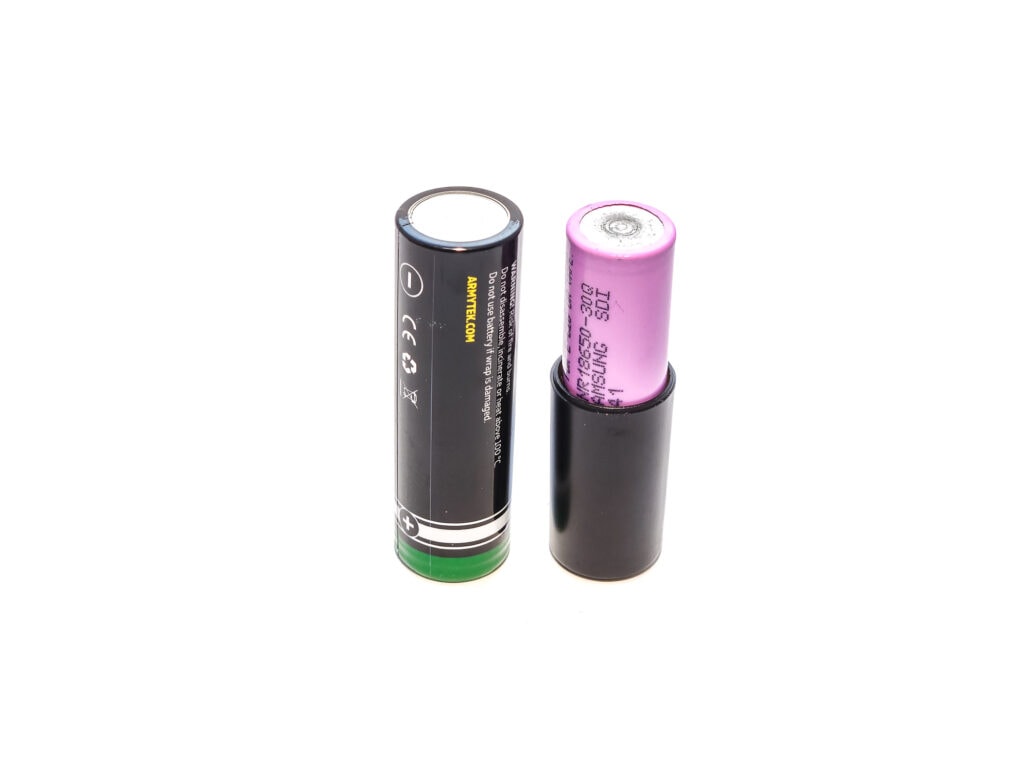
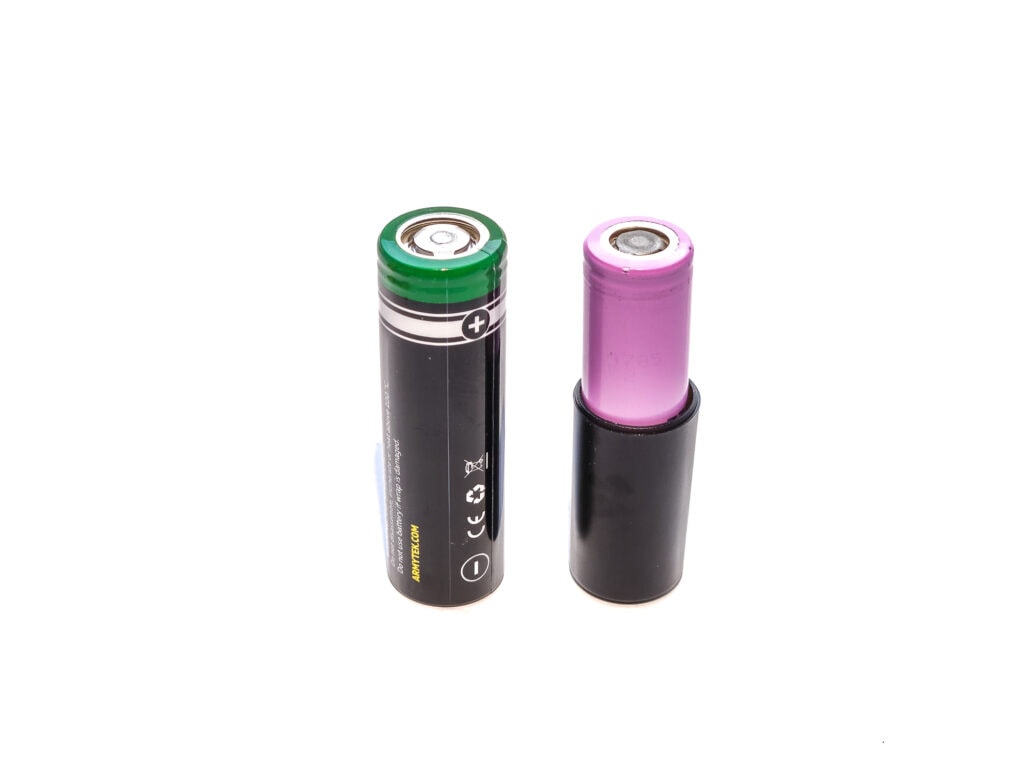
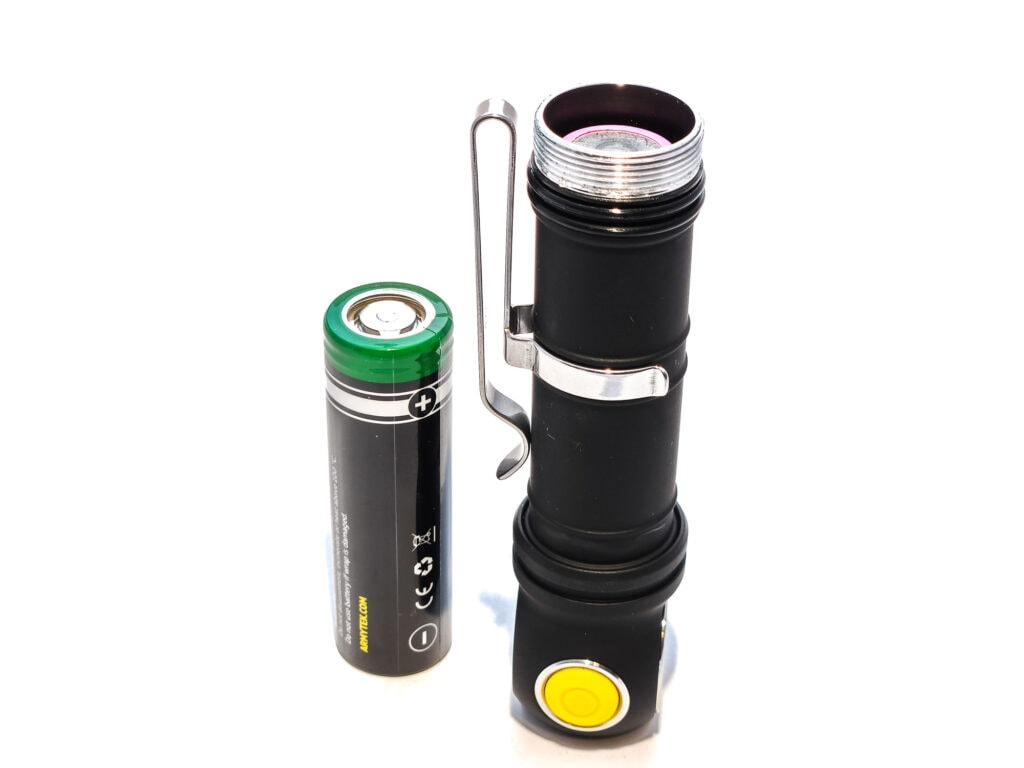
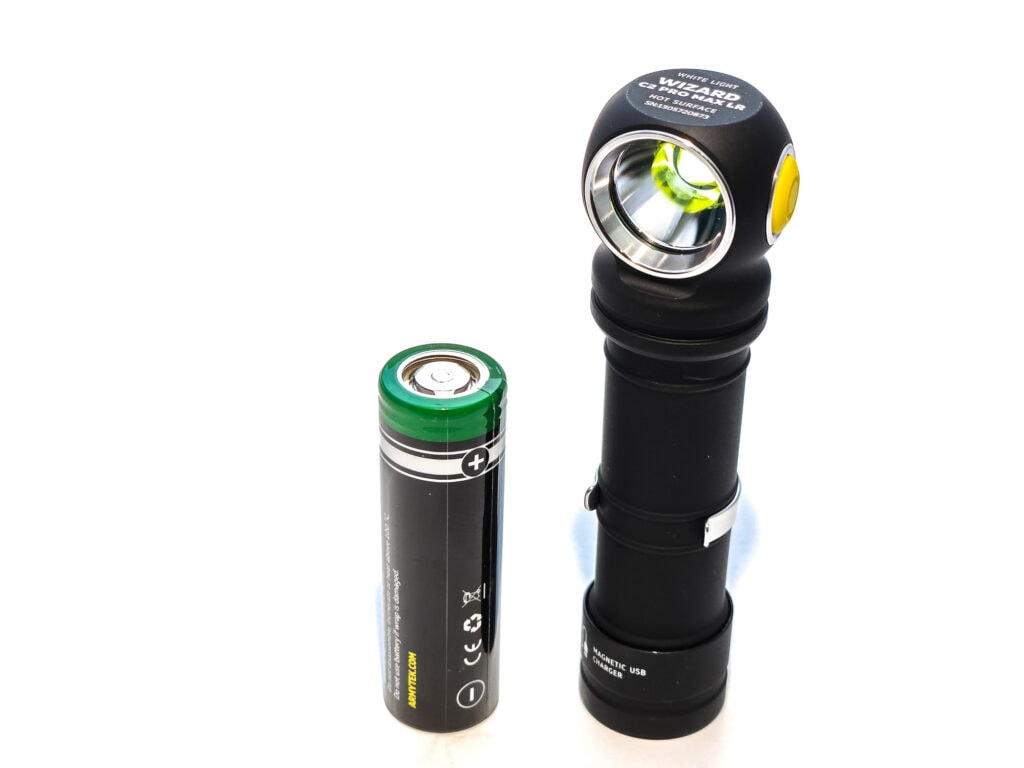
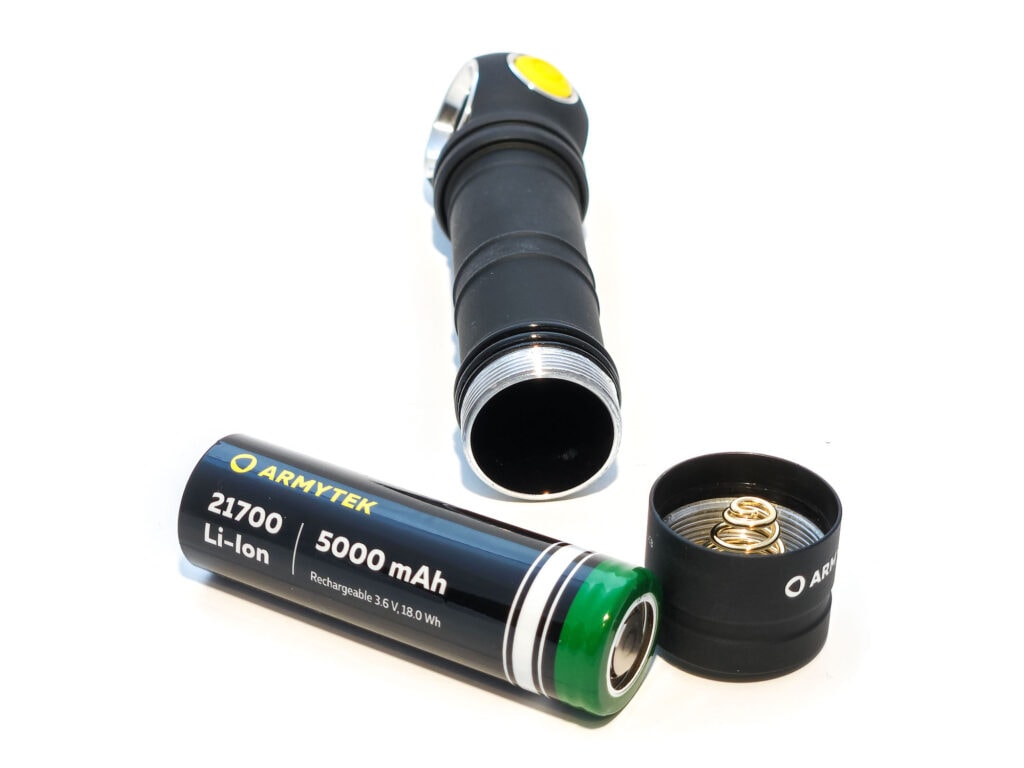
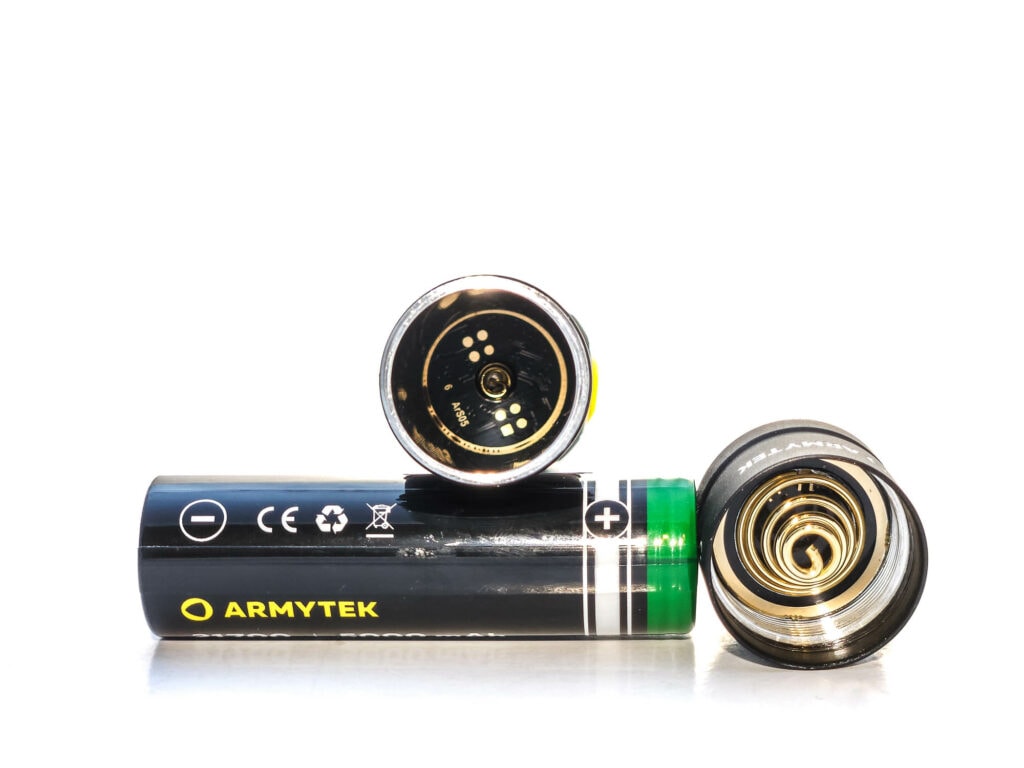
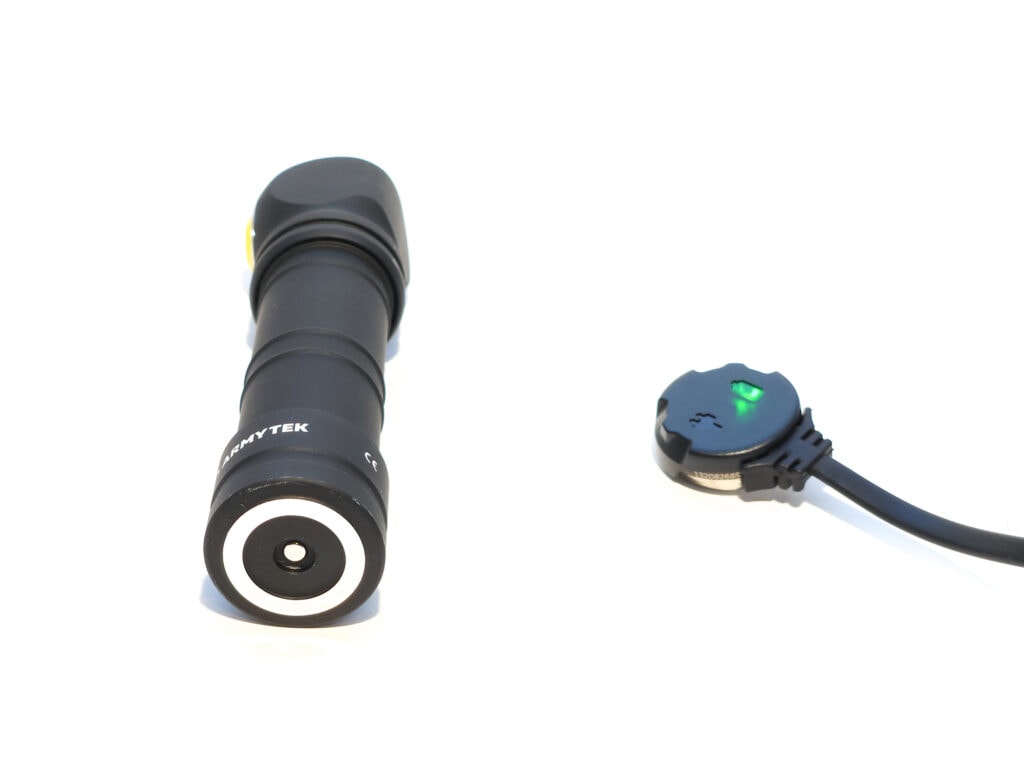
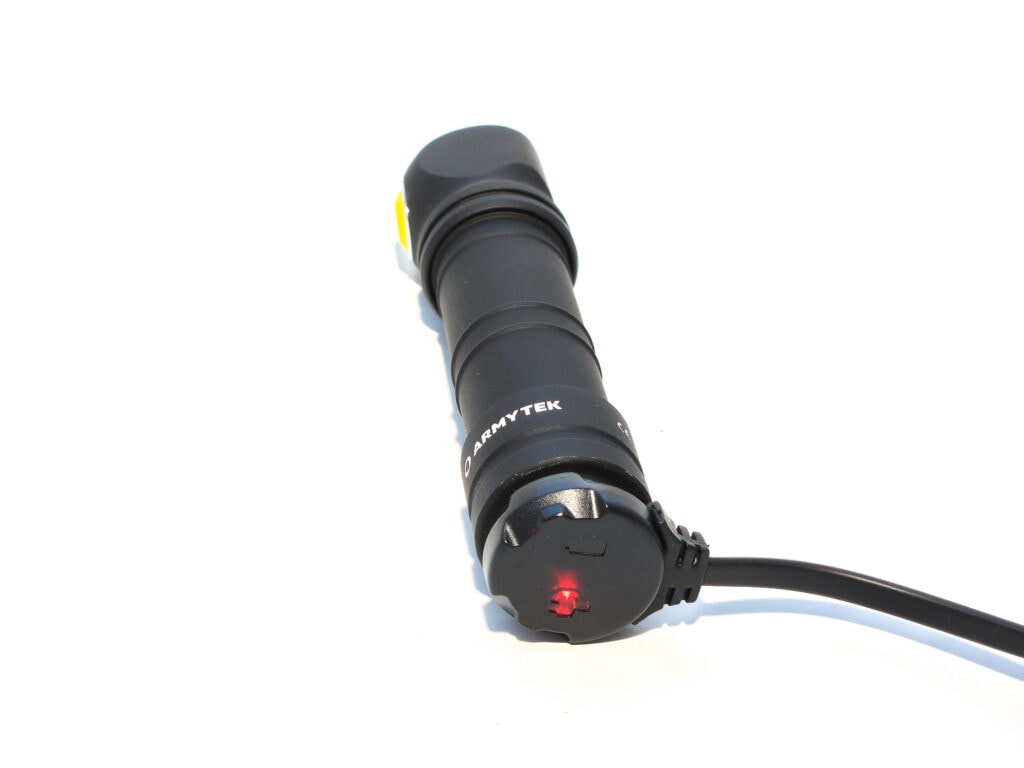
Performance test
Lumen measurements
How Lumens are Measured: Understanding ANSI FL1 Standards How Lumens are Measured: Understanding ANSI FL1 Standards: The ANSI FL1 standards specify that output in lumens should be measured 30 seconds after turning on, as this is the standardized time for measuring brightness according to the industry standard. This is why we focus on this part in our measurements. The ANSI FL1 standards require an ambient temperature of 22 ± 3°C. We record the ambient the ambient temperature to identify potential reasons for any observed discrepancies.To obtain these numbers, I used a very rudimentary integrated shoebox and ceilingbounce on my Samsung Galaxy S10. Measurements have been calibrated using a standardized calibration light provided by 1Lumen.
My measurements of the Wizard’s output were off on every level, but it’s still putting out a ton of light and due to the way brightness needs to be four times as much in order to appear twice as bright, it’s not going to be an extreme difference.
| Mode | Amps at start | Specified | Start | 30 sec. | 10 min. |
|---|---|---|---|---|---|
| Firefly1 | 0.00 | 0.6 | 0 lm | 0 lm | 0 lm |
| Firefly2 | 0.01 | 7 | 4 lm | 4 lm | 4 lm |
| Main1 | 0.13 | 45 | 68 lm | 69 lm | 70 lm |
| Main2 | 0.27 | 150 | 146v | 146 lm | 146 lm |
| Main3 | 0.70 | 450 | 407 lm | 403 lm | 400 lm |
| Turbo1 | 2.22 | 1300 | 1038 lm | 1024 lm | 982 lm |
| Turbo2 | 6.37 | 4150 | 3101 lm | 3101 lm | 771 lm |
| Turbo2 at 3.6V | – | – | 2313 lm | 694 lm | 696 lm |
Amps were measured with a Klein Tools MM300 digital multimeter to the best of my ability.
Parasitic drain:
- 0.00 µA/mA
Armytek Wizard C2 Pro Max LR Battery Life: Runtime graphs
How Runtimes are Measured: Understanding ANSI FL1 Standards About ANSI FL1 runtime standards: The runtime is measured until the light drops to 10% of its initial output (30 seconds after turning on). This does not mean that the flashlight is not usable anymore. The last column shows how long the light actually works till it shuts off. If there is a + symbol, it means that the test was stopped at that particular point, but the light was actually still running. This happens on certain occasions, with certain drivers, firmware, or batteries.Note that the total runtime here is measured until the light dropped to Firefly1 level. This is because it would stay at that level for over 24 hours and I don’t have weeks to run each runtime measurement. The lower levels were also not measured fully due to their long runtimes.
| Mode | Specified | Measured runtime ANSI | Time till sub lumen |
|---|---|---|---|
| Firefly1 | 62d | – | – |
| Firefly2 | 10d | – | – |
| Main1 | 64h | – | – |
| Main2 | 21h | – | – |
| Main3 | 7h | 6h 58min | 6h 58min |
| Turbo1 | 3h 20min | 2h 51min | 3h 32min |
| Turbo2 | 3h 15min | 2h 47min | 3h 34min |
Main3 makes it almost all the way to the advertised runtime, though the two turbo modes’ quoted runtimes look more like their total runtime rather than the ANSI runtime. They do hold a steady output for the duration of their regulated runs
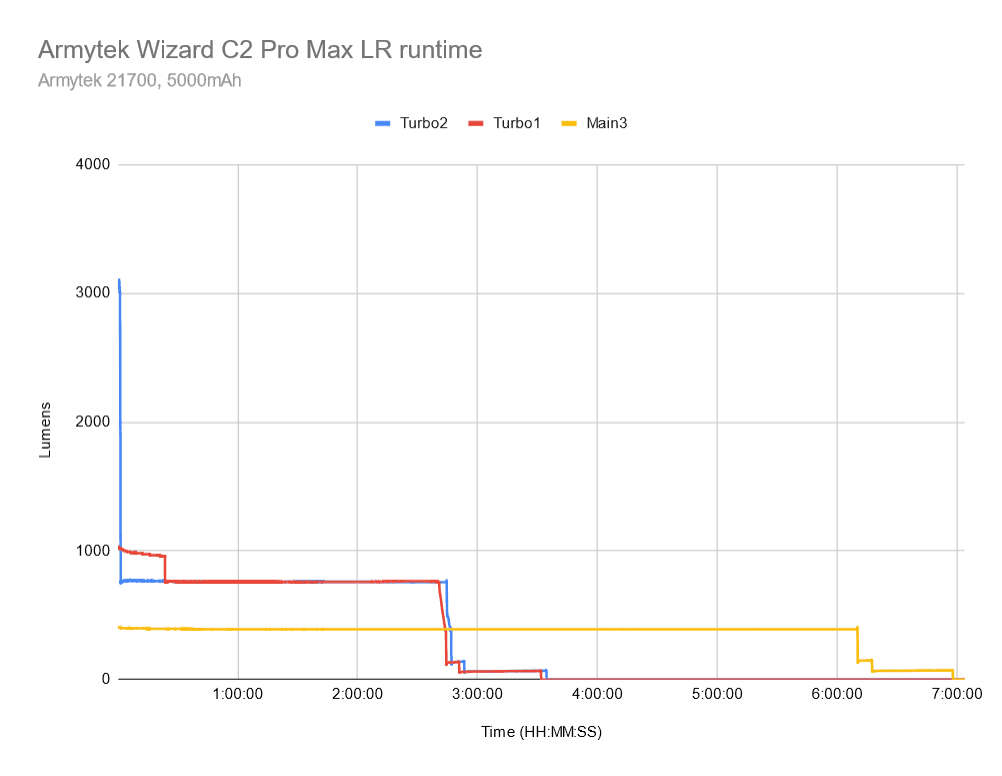
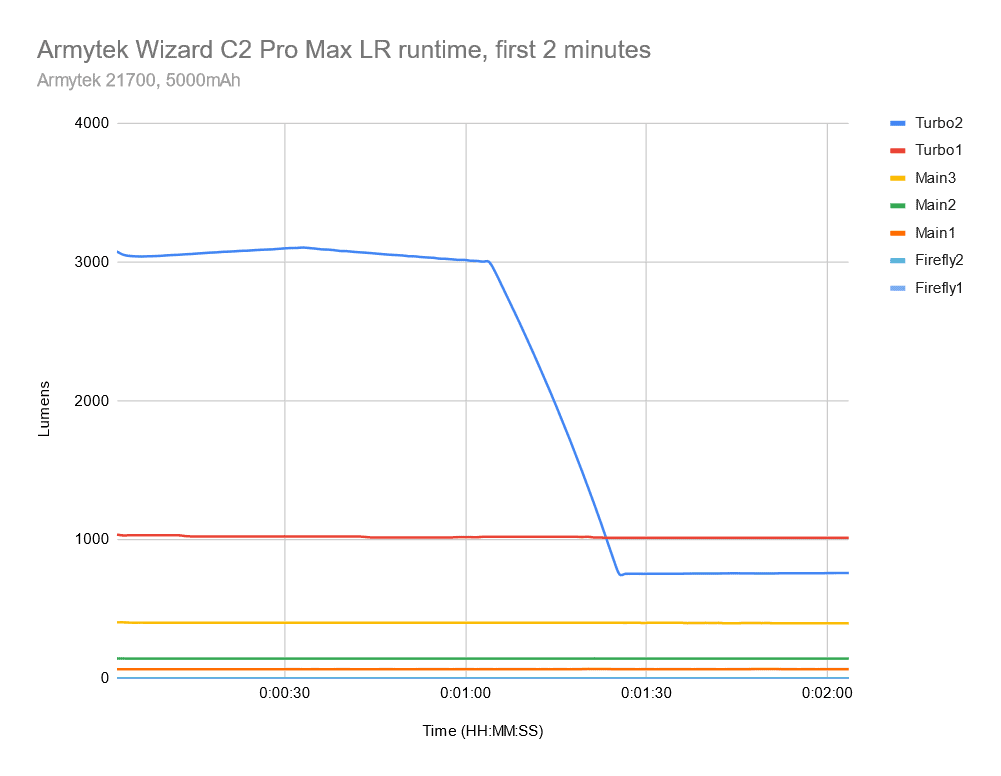
Peak beam intensity and beam distance measurements
About Peak beam intensity: Understanding ANSI FL1 Standards About peak beam intensity The calculated value of distance in meters at which the flashlight produces a light intensity of 0.25 lux. (0.25 lux is about the brightness of a full moon shining on an object). This means that the intensity has decreased so much, it becomes difficult to see darker objects, or objects that don’t reflect light. The columns ‘Meters’ and ‘Yards’ use rounded numbers.The numbers for candela were obtained with a UNI-T UT383S luxmeter at 5 and 15 meters, then averaged.
| Mode | Specified | Candela measured | Meters | Yards |
|---|---|---|---|---|
| Firefly1 | – | – | – | – |
| Firefly2 | – | 18 cd | 8 m | 9 yd |
| Main1 | – | 141 cd | 24 m | 26 yd |
| Main2 | – | 353 cd | 38 m | 42 yd |
| Main3 | – | 846 cd | 58 m | 63 yd |
| Turbo1 | – | 2820 cd | 106 m | 116 yd |
| Turbo2 | 181 m | 9506 cd | 195 m | 213 yd |
Well, in Turbo2, the Wizard certainly earns its long range name! That’s a hefty throw for a headlamp!
Beamshots
These were taken with a Samsung Galaxy S22+ using pro mode and the following settings:
- WB 5000K
- ISO 200
- Speed 0.5
Distance to the other end of the playing field is 100 meters. As you can see, the Wizard casts Light across the length, and much of the width, of the field.
Beamshots of the following flashlights compared:
- Armytek Wizard C2 Pro Max LR
- Skilhunt H300
- ThruNite Thrower
Please note that the following beamshots are mainly intended to showcase the beam pattern and beam quality, rather than overall performance. These images are typically taken directly after activation, and in different seasons or weather conditions, and therefore do not fully represent its overall performance. For accurate performance metrics, such as output, beam distance, and runtimes, you need to look at the performance section of this review.
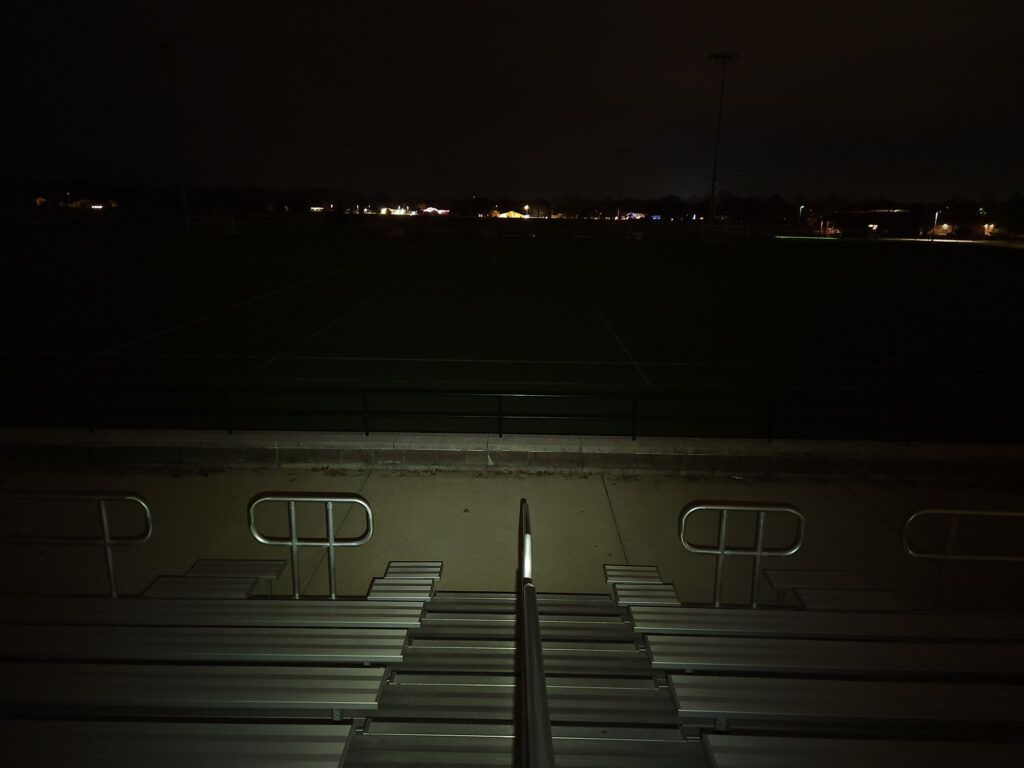
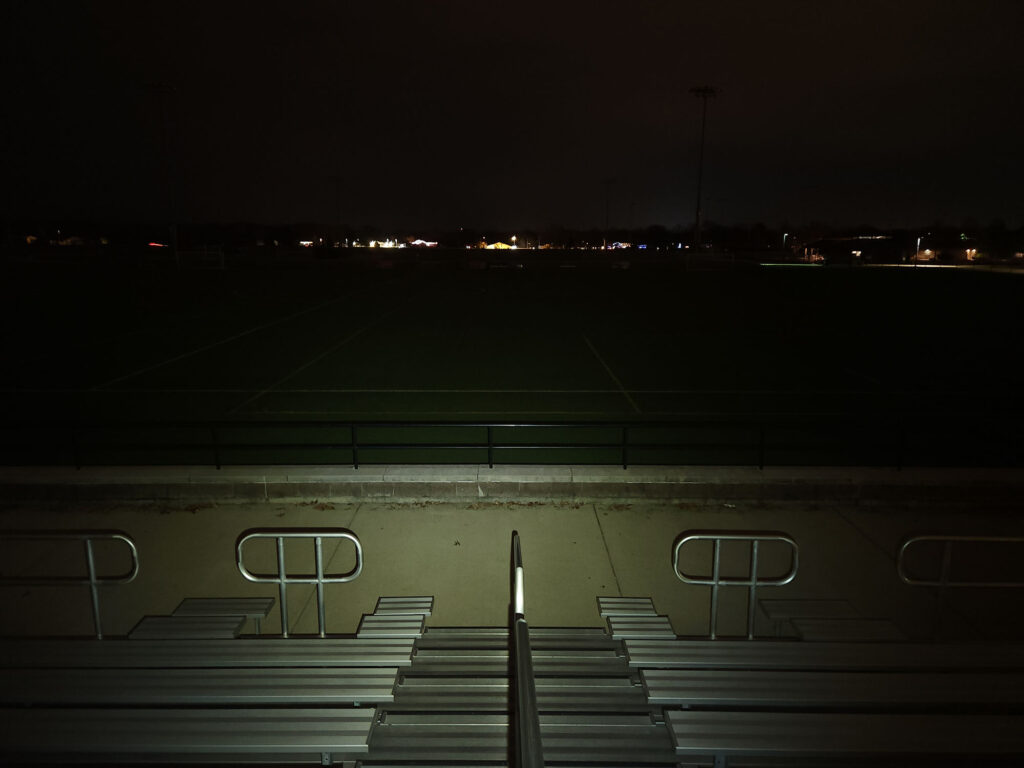
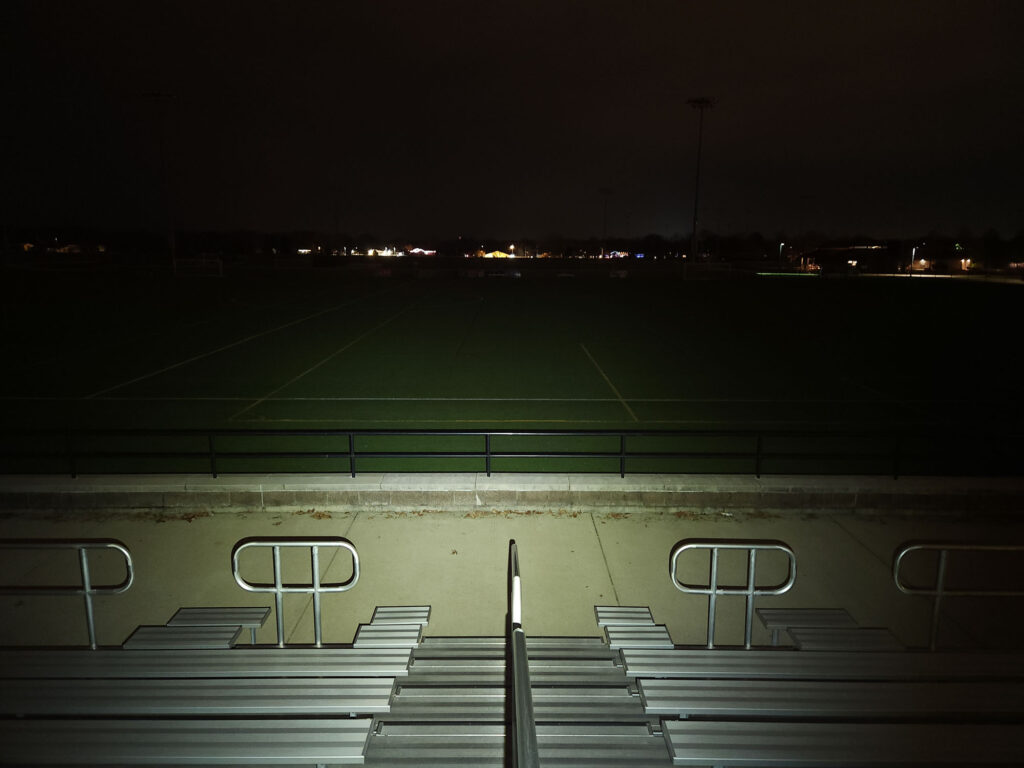
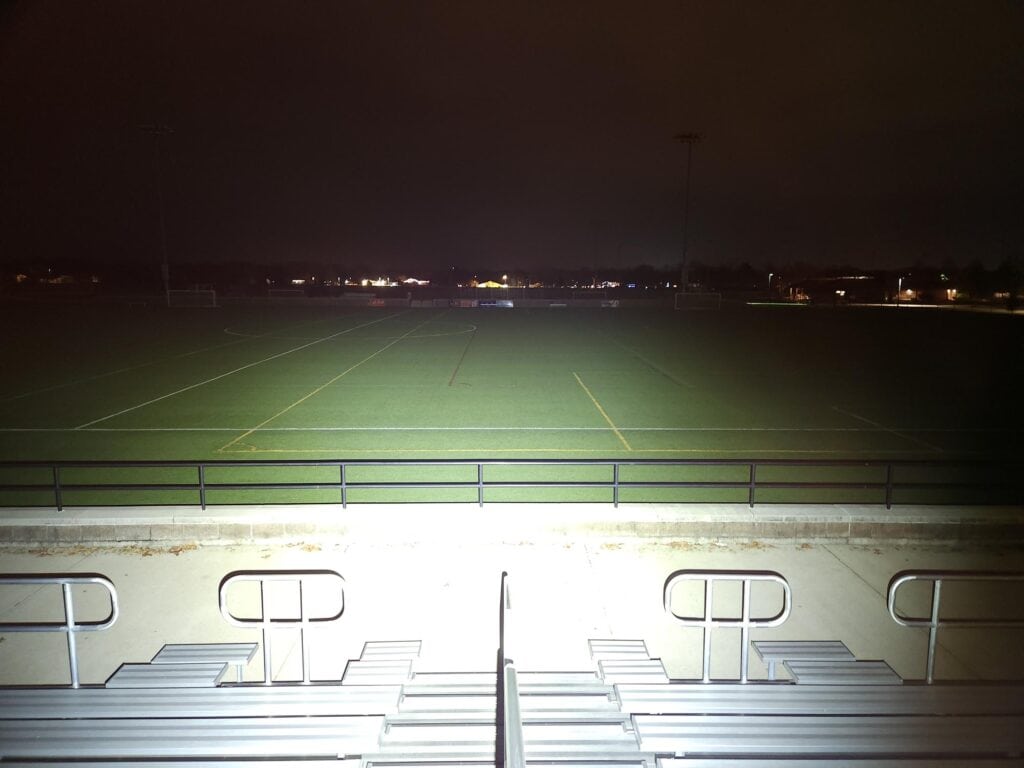
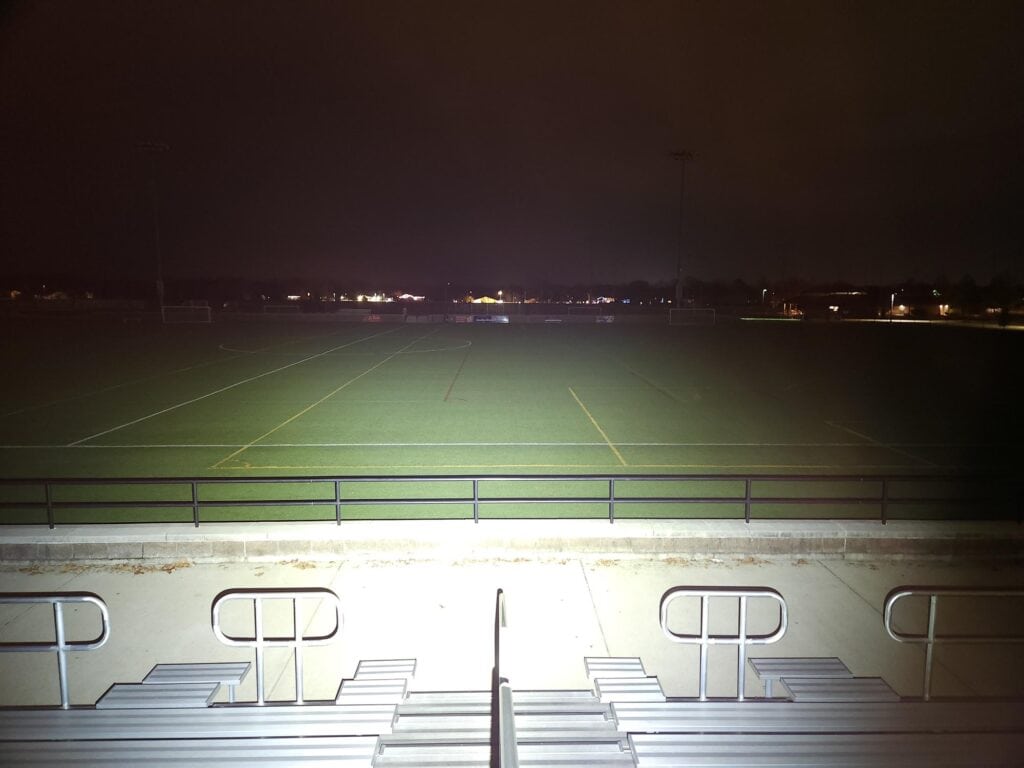
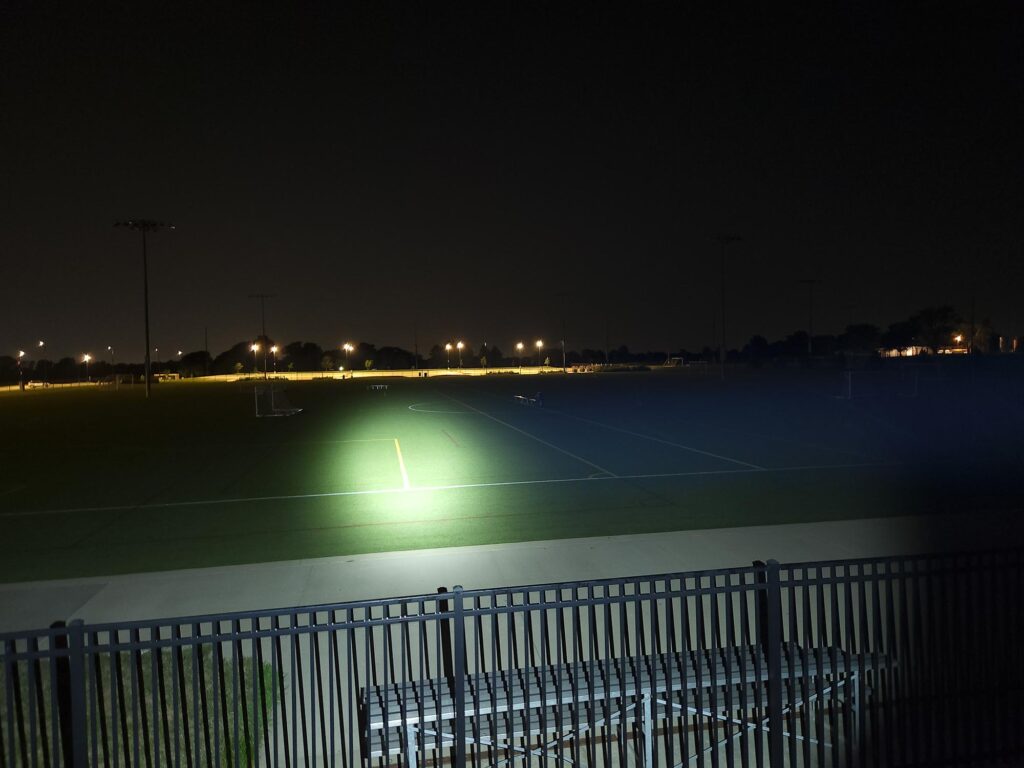
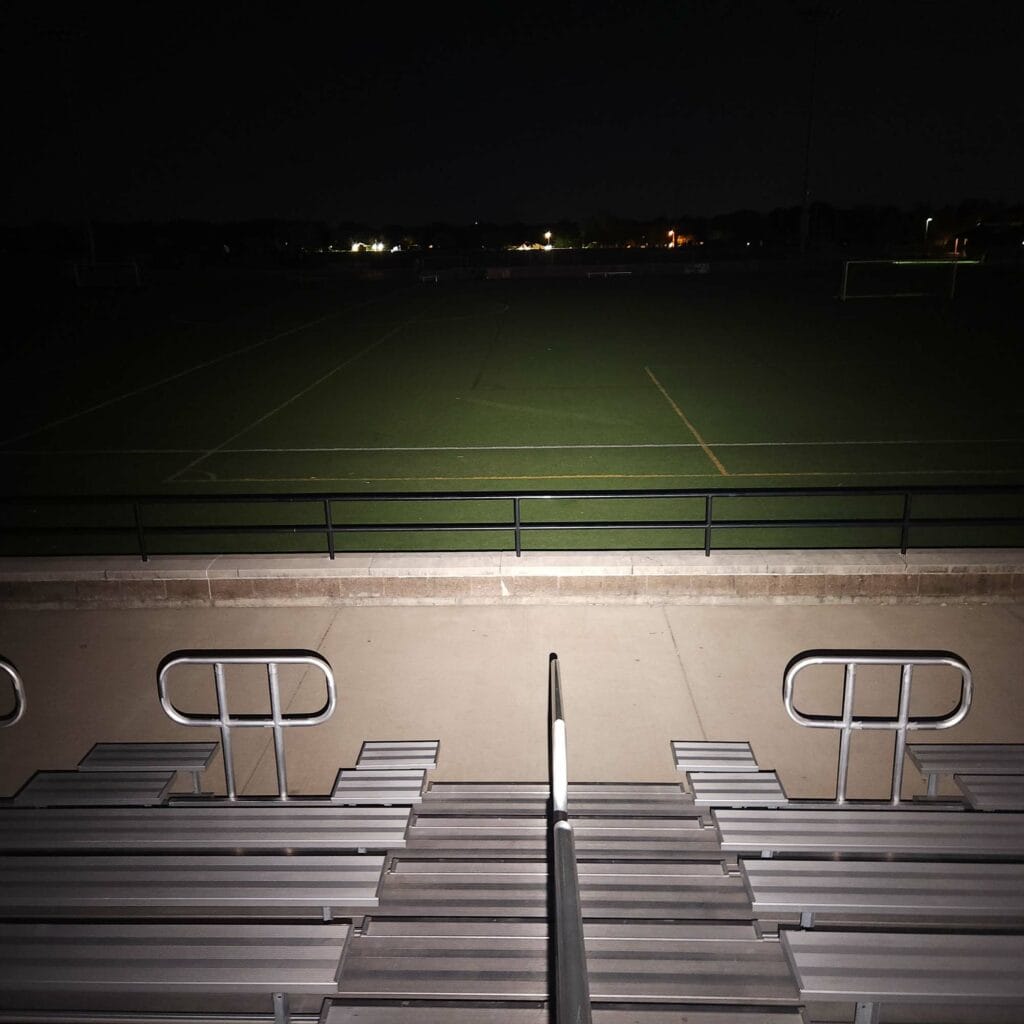
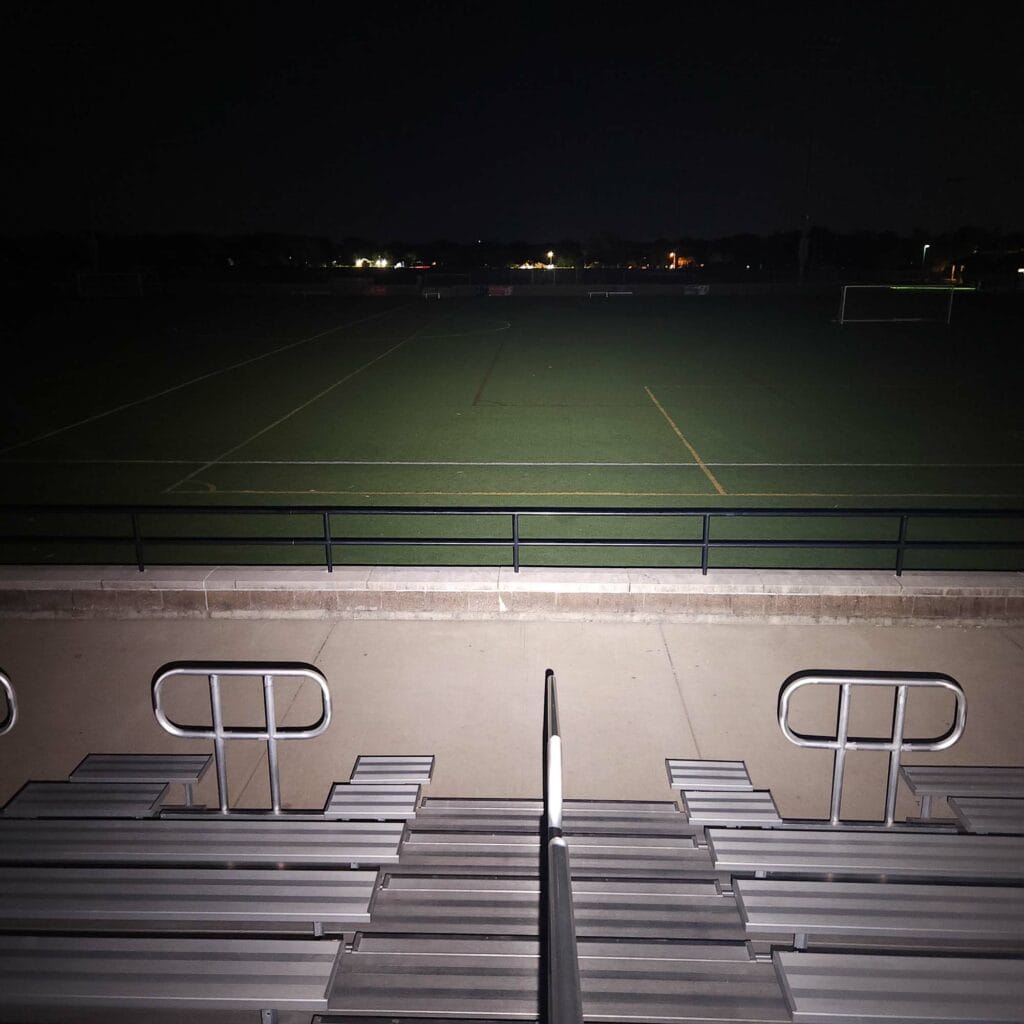
Disclaimer: This flashlight was sent to us for review at no cost by Armytek. We have not been paid to review, nor have we been holding back on problems or defects.
Final Verdict
Pros
- Long Range, indeed!
- Regulated output
- 21700 will provide high power and long runtime
- Better claimed toughness than other lights (10m water, 10m fall)
- Easy to use as a headlamp
Cons
- Have to unscrew the light 1/4 turn to charge
- Slow charging
- Lower than advertised lumens and battery capacity
- Requirements for warranty work seem very strict
Explanation on star ratings:
1: Avoid: a match would be a better choice – 2: Poor: significant defect or issues; almost unusable – 3: Average: some defects or issues; but still usable 4: Good: recommended (minor issues) – 5: Great: highly recommended

5 stars: ★★★★★
While our star rating provides a reliable indicator, we encourage you to read the full review to make an informed decision based on your own needs and preferences.
It looks like Armytek has another winner here; the Armytek Wizard C2 Pro Max LR CW can throw light as far as its name is long. It has to be a larger 21700-sized headlamp to do so, because that XHP70.2 is a hungry beast, but it gets the job done.
Plus with its regulated output, you know how much light you’re getting and how long it’ll last. The only irritations it comes with are that you have to unscrew the tailcap to charge, and it takes seemingly forever to charge the 5000mAh battery, but if you don’t mind that or the weight, you might want to check this out.
I give this light five stars for being strong, solid, and doing what it set out to do.
Buy your Armytek Wizard C2 Pro Max LR here:
1lumen selects and reviews products personally. We may earn affiliate commissions through our links, which help support our testing.